|
Short accounts by Tring residents of
aspects of their lives and of past events,
collected and preserved by local historian Jill Fowler.
――――♦――――
|
CONTENTS
TRING AT WAR 1914-1918, by John Bowman
THE COUNCIL, by Bob Grace
TRING FIRE SERVICE
(author unknown)
ALL BECAUSE THE FIRE
BRIGADE WASN'T THERE? by Denis Aldrige
THE FIRE BRIGADE, by
Jill Fowler
THE
WRITINGS OF FRANK JOHN BLY,
antiques dealer
EARLY DAYS OF THE WAR, by Doris Miller
MEMORIES OF A TRING EVACUEE,
by
Joyce Hollingworth
EMUS, TOBOGGANS,
FIREWOOD AND OLD TIN PLATES, by Ron Kitchener
AKEMAN STREET IN THE 30s AND 40s, by Doug
Sinclair
THREE GENERATIONS OF FARMERS IN TRING, by Stephanie Wells
MEDICINE IN TRING - A SHORT HISTORY, by Dr. D. F. E. Thallon
SEVENTY YEARS AGO, by
Dennis Aldridge
THE TRING ASSOCIATION
FOR THE PROSECUTION OF FELONS
THE CLUBS OF A HUNDRED
YEARS AGO, by Jill Fowler
TRING AND THE MOTOR CAR,
by Jill Fowler
TRING STATION - TRUTH
AND HALF TRUTH, by Tim Amsden
MEMORIES OF TRING IN THE
THIRTIES, by Jerry Spencer
BORN IN THE
SAME YEAR AS THE QUEEN,
by Pam Cockerill
――――♦――――
TRING AT WAR 1914-1919
Researched and written by John Bowman.
August 1914: Reservists were reporting to their Naval and Army establishments,
and the Territorial Army mustered at their local drill halls.
The Territorials were primarily a home defence force of volunteers
who were requested to sign for service where required; the majority
volunteered at the outbreak of war.
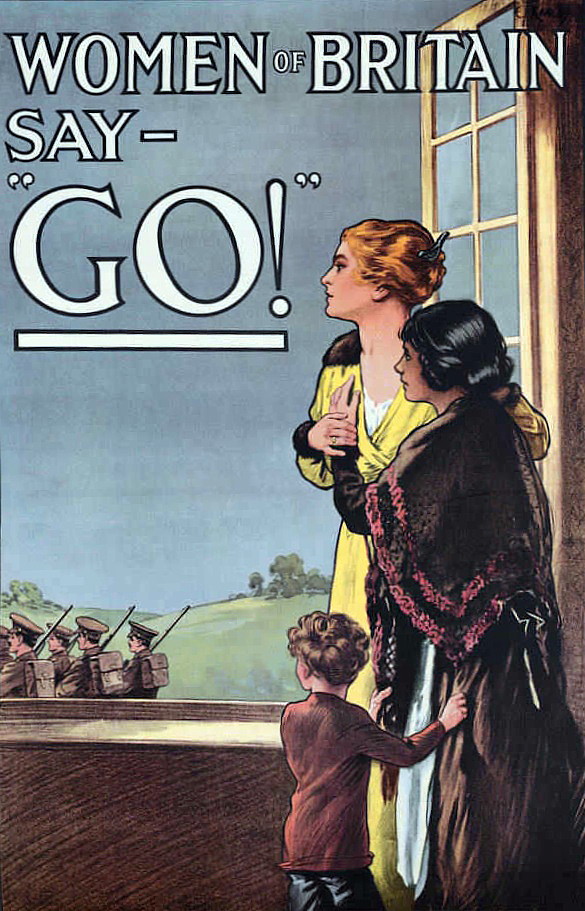
Lord Kitchener, an outstanding military engineer and soldier, and well
known for his service in Egypt, The Sudan and South Africa, was appointed
Minister of War. He immediately asked for 100,000 volunteers to
supplement the small regular army, most of which was engaged in
France supporting the French and Belgians against the Kaiser’s army.
The 100,000 target was achieved in the first few days following the
proclamation. Preparations were then made for the recruitment of a
further 100,000 men.
In September 1914, it was rumoured locally that a new Army Division
was to be formed at Halton Park, which had been offered to the crown
as a Rothschild contribution to the war effort. A tented camp was
erected on what is now the Halton Airfield and men began arriving
from the north-east, from Northumberland, Durham and
Yorkshire to form the new army’s 21st. Division.
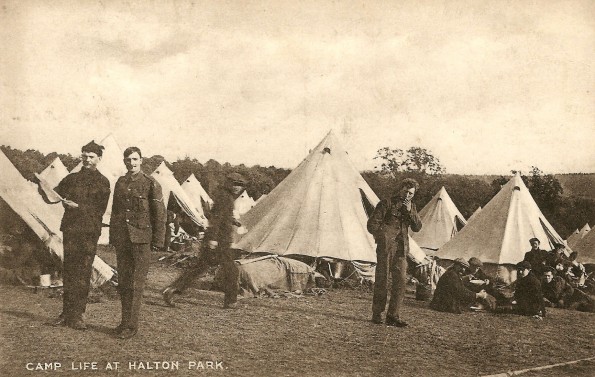
Due to a very wet autumn, the tented camp was soon waterlogged and
the soldiers were out housed in any available accommodation. Three
thousand soldiers were billeted in Tring, mostly with local
householders.
The school in the High Street was commandeered. The pupils were
accommodated in various locations. The boys went to the Church House
and Market House/Hall. The girls went to the lecture hall in the
High Street Free Church, and the Western Hall, which was situated
where Stanley Gardens is now.
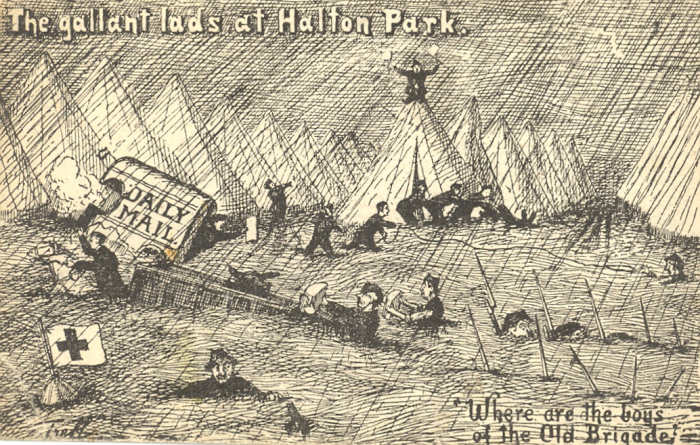
The ‘gallant lads at Halton Park’ in a
sea of mud.
The Victoria Hall and the Gravelly School became medical and
hospital accommodation, the infant pupils being housed in the
Sunday School Room of the Akeman Street Baptist Chapel. The YMCA
building, in the Tabernacle Yard, Akeman Street was opened as
writing and reading rooms for the soldiers. Bathing facilities were
installed in the Museum’s outbuildings.
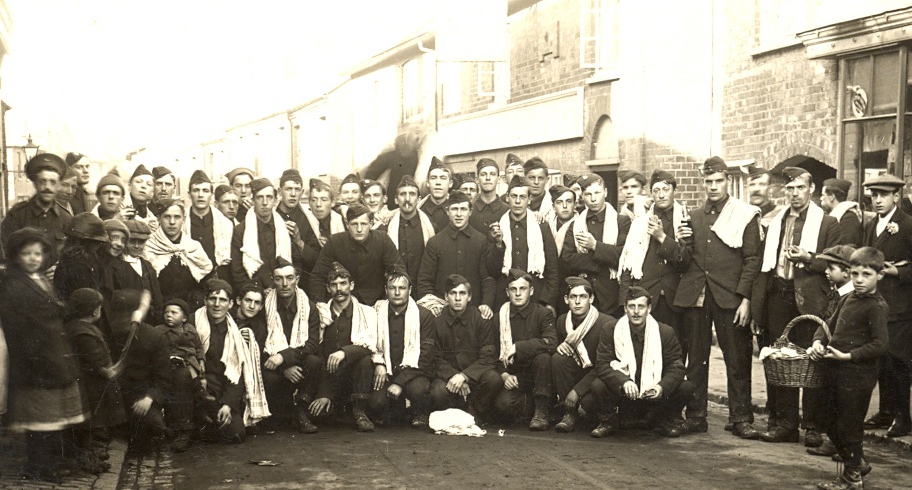
A bathing parade.
The billeting rates paid for soldiers were quite generous for the
time and, no doubt, supplemented the income of the townspeople,
which was lost when so many of the population volunteered.
In November, it was reported that Arthur Wells who lived at
Tringford had been lost at sea. He was a stoker in the Royal
Navy, and had been recalled at the beginning of the war. He
was serving in HMS Aboukir, a cruiser. His Majesty’s
Ships, Aboukir, Cressy and Hogue were elderly ships of the “Battle”
class [Ed. – Cressy class] and all three were lost, torpedoed in
the North Sea, on the same day, 22nd September 1914. Reginald
Seabrook of Tring, a seaman, was serving on HMS Hogue when it was
sunk and he was picked up from the sea.
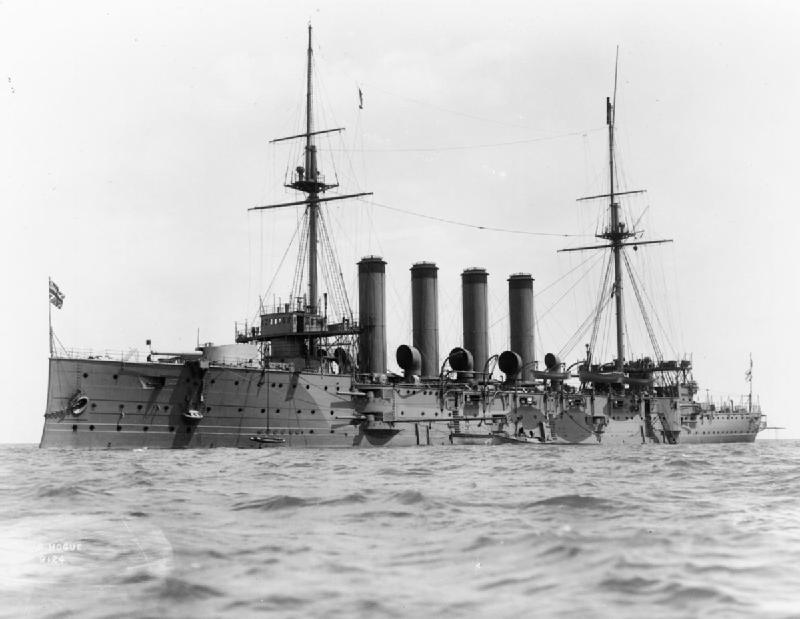
Together with sister
ships Aboukir and Cressy, HMS Hogue was torpedoed and
sunk in the North Sea by the German submarine U-9 on the 22nd September,
1914.
In total,
62 officers and 1,397 enlisted men were lost in this disastrous
engagement,
which revealed to a complacent Royal Navy the danger of submarine
warfare.
In Tring, various groups of ladies were knitting comforts for the
troops, scarves, gloves and balaclava helmets were welcomed by all
the troops in the trenches. The front had settled to a line
which was to stay until early 1918. The trench systems
throughout were an elaborate mishmash of deeply excavated trenches
in the Arras/Somme area, to built up defences in the flat coal
mining areas around Vimy/Lens/Bully and the Ypres salient, where
water would appear at two to three feet under the surface.
Large quantities of sandbags were needed for the defences.
Also wattle hurdles, chestnut paling and withy fascines. The
manufacture of these was a rural craft, a local industry. Of
course, the manufacture of sandbags was a commercial undertaking.
It is estimated that each division of 15,000 men would need over one
million bags a month.
The voluntary effort by women’s groups to make sandbags was
organised by a Miss Tyler who worked from North London as a
collecting point. The purchase of hessian was undertaken
locally, in the Home Counties. Women’s groups made the bags
measuring 33 inches long by 14 inches wide. By September 1914,
10,000 sandbags a day were dispatched to the front. The
collecting point in Tring was Hazely, a street in Tring, where Miss
Helen Brown and her helpers bundled the sacks for collection.
All costs for this enterprise were met by public subscription.
Every pound raised provided 60 bags.
A poem written by a soldier of 21st Division:
|
The boys from Halton Park
There are five and twenty thousand
Bold recruits who have made a start
To train to fight for their country
In this spacious Halton Park.
When they are trained and ready
To the front they will embark.
Then you will hear the people say
‘There’s the lads
from Halton Park’
And when Berlin is taken,
The Kaiser will remark
“Where did those fearnoughts come from?”
Why, of course, from Halton Park.
And when we come home victorious,
And each man has made his mark
Where will the honours go to?
Why,
the lads from Halton Park. |
Summer 1915: the district nurse,
Miss Girardet, has
resigned and is presently nursing at the military hospital on
Wandsworth Common. She has been thanked for her 17 years
service to the community. Miss Green has been appointed in her
place.
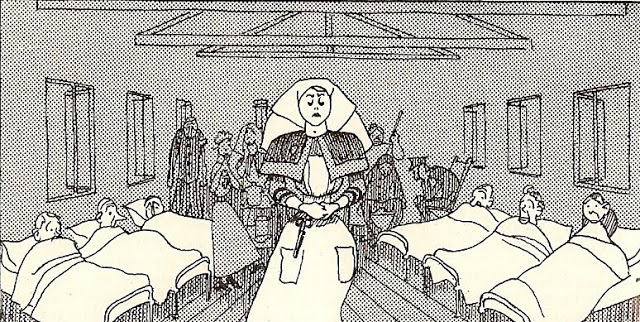
A cartoonist’s view of the Wandsworth
Military Hospital.
|
“Miss Girardet has been
here as a Staff Nurse since October, 1914. She is one of
the most capable nurses we have, and is generally loved
by all of us for her kindness and goodness to those
around her. She was trained at Westminster Hospital and
has been District Nursing since.” Fanny Clara
Girardet was later awarded Royal Red Cross Medal for her
wartime services. |
The 21st Division are now in France and have been in action around
Loos/La Bassée. Halton Camp is now the training facility for
the East Anglian area.
Gallipoli has been evacuated. A combined force of French and
British troops, have occupied Salonica and have moved into Thessaly
and Macedonia, in support of the retreating Serbian army. The
Kitchener battalions of the Oxford and Bucks Light Infantry are part
of the force. A number of local men are in these battalions.
The casualty lists are depressingly long. Almost every family,
locally has either lost a relative, or had news of one wounded or
taken prisoner.
The production of shells and ammunition is being co-ordinated by the
government. The shortage in 1915 was felt by our armies on the
Western Front, and is no doubt the main cause of our failure to
progress militarily.
1916: saw the National Service Act coming into operation. This
allowed the direction of the work force as required for the war
effort. Local tribunals were established, which allowed
exemption for men with large families, men and women who held
essential jobs and men running family businesses and farms.
The pronouncements of the tribunals were not always acceptable, and
recourse to an appeal board was often sought.
The shortage of food, due in part to the German submarine warfare is
having a serious effect on the population. The licensing laws
were changed, with pubs having restricted opening hours. These
restrictions remain virtually to the present day.
|
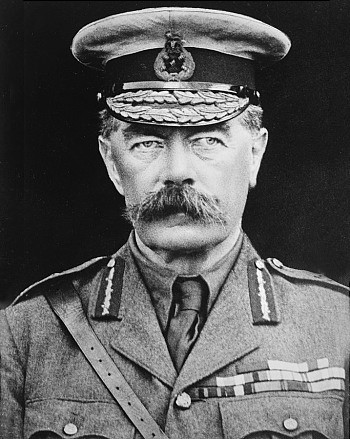 |
|
Field Marshal Lord Kitchener
(1850-1916) |
HMS Hampshire, a cruiser, was sunk north of Scapa Flow in the Orkney
Islands on June 5th 1916 [Ed. – Hampshire is believed to have struck a
mine laid by the German minelaying submarine U-75. She sank with
heavy loss of life]. She had on board, Lord Kitchener and
a delegation, which were on their way to Murmansk in Northern Russia
to meet the Russian Imperial Command. Lord Kitchener’s
body was never found. However, Able Seaman Stanley Collier,
one of the crew, was recovered from the sea and buried in the
military cemetery on the island of Hoy. He was a Tring man and
is commemorated on the Tring war memorial.
The Chiltern beech woods were being cut down to provide timber for
the trench systems in France. Three forestry engineer units
were at work in the area, one being from Australia. The
consumption of timber was so great at the front that a special port
facility was built on the river Seine, at Rouen, solely for the
handling of timber.
The meadows in the Vale of Aylesbury were in great demand for the
production of fodder for horses, many thousands of which were used
for transportation and supply by the Army, at home and in France.
At Paines End, just over the county boundary in Drayton Beauchamp
parish, the Royal Engineer (Signals) had established a small unit
engaged in radio communications. They were housed in tents and
a portable canvas hut. The lady in a cottage nearby was asked
if she could supply hot water for the soldiers’ ablutions. She
said she would, but that she had no fuel to heat the copper
in the outhouse. The next morning there was a visit from the
Bucks policeman from Aston Clinton. He asked if the family had
seen anybody passing with ‘wooding’ trolleys, as a quantity of
timber was missing from Pavis Wood. Later that day the estate
policeman came and asked the same question. Of course, the
woman denied having seen anybody passing. When she next went
to the outhouse, she found it was full of logs!
During 1916 the British and Commonwealth armies took over most of
the front extending from the Somme River to a point north of Ypres
where the remnants of the Belgian Army held the front to the Channel
coast. Preparations were made for a major attack to be made in
the area north and south of Albert, which we now know as the Somme
offensive. The battle raged for four months.
During this time many names were added to the Tring Roll of Honour,
many men were posted as missing, believed killed. On March
19th the Church Council discussed the building of a war memorial to
commemorate the young men of Tring who gave their lives during the
war. It was suggested that the memorial should take the form
of a crucifix, similar to the roadside memorials which are found in
France and Belgium. This would be very familiar to all the
soldiers who had served and would be a fitting reminder to the
living and memorial to the dead. It was agreed to commission a
design showing Christ crucified on a cross.
War savings groups were being formed. Street Marshals
collected the pennies in exchange for stamps which were affixed to
cards. When full (15/6d) they were exchanged for a certificate
worth a pound sterling in five years. This type of saving
continues to the present day in a similar form with the National
Savings Bank.
Rationing (1917): food is becoming short due to the German
submarine warfare waged against our merchant ships.
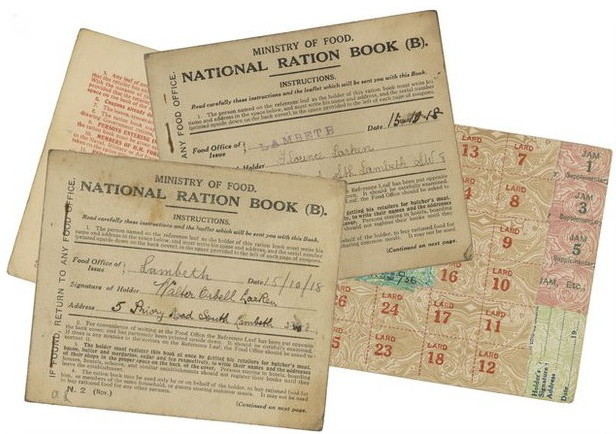
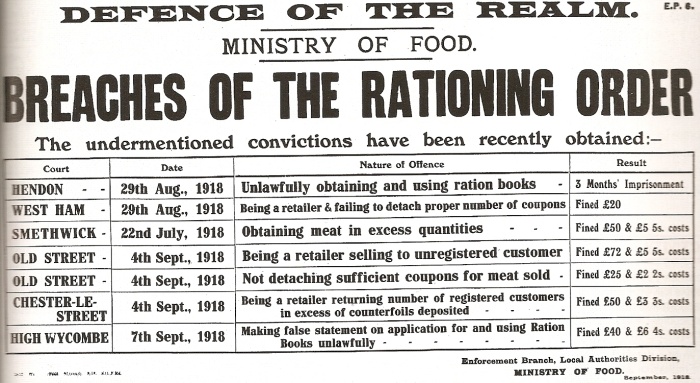
The shortage of
labour on the land is being circumvented by the formation of a corps
of women volunteers known as The Women’s Land Army. Young
women are also being directed into munitions factories. The
naval and military have their own women’s arms, the WRNS and WAC’s.
The women are taking over the duties of motor drivers, cooks,
clerks, etc., allowing the release of men to fill the gaps in the
fighting services.
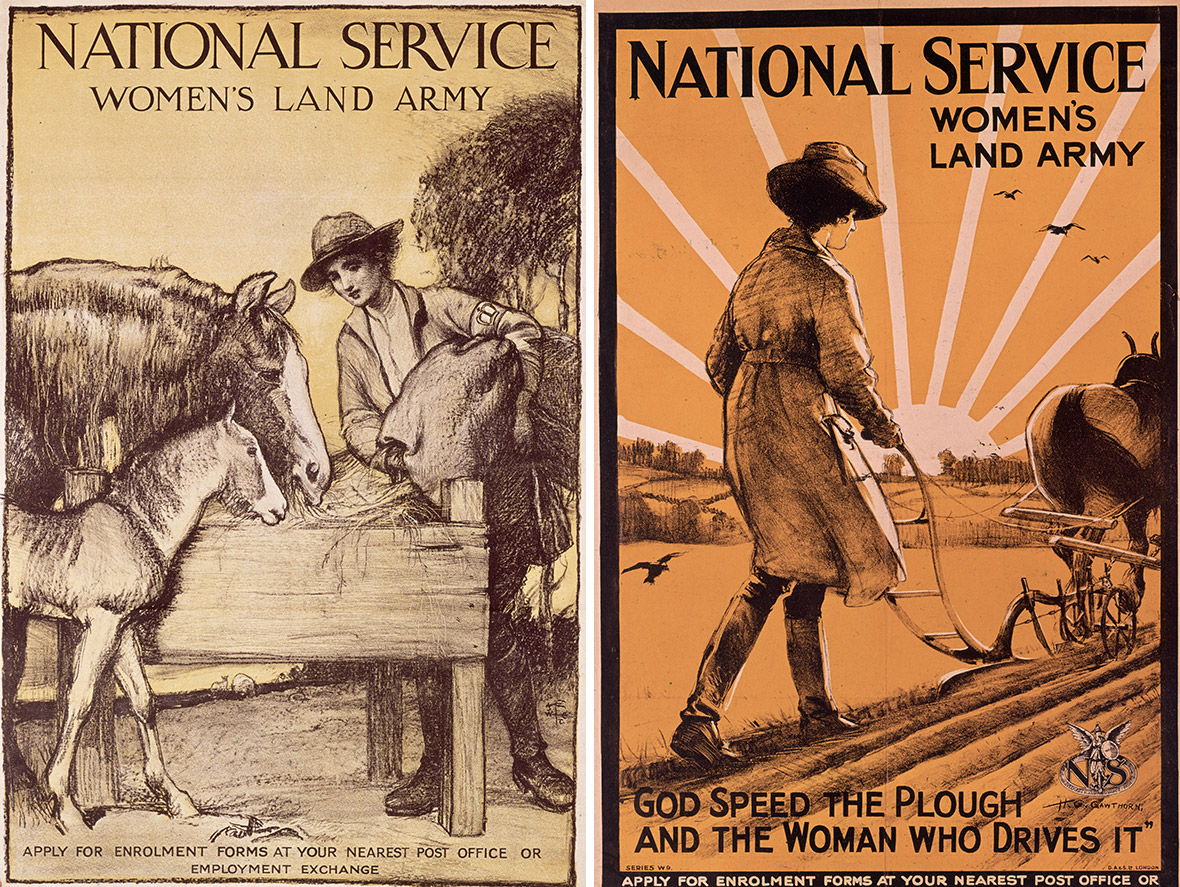
Halton is still the Eastern Command Training Depot. The Royal
Flying Corps are moving into the North Camp area. A flying
field has been established, with an Australian squadron flying from
it. The Royal Flying Corps training organisation, concentrated
in the new workshops being built by German prisoners of war under
the direction of the Royal Engineers, has trained 15,000 Air
Mechanics during 1917.
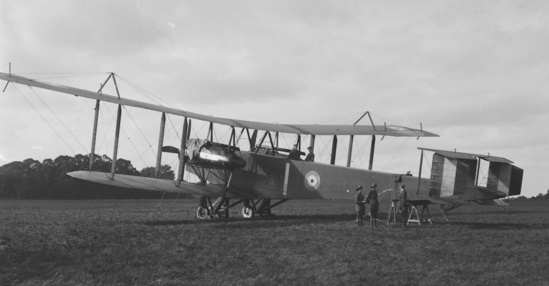
A Handley Page 0/400 bomber displaying Royal
Flying Corps insignia at the
Australian Flying Corps Training Depot,
Halton Camp.
On the Western Front, an offensive was started in the Arras area
during the early spring. The German army was pushed back,
resulting in the capture of Vimy Ridge by the Canadian Army Corps.
Although the high ground was not of a great height, it did hold a
commanding view over the Douai plain, with its coal mines and
industrial complex towards Lille and the south Belgian bulge.
The Bolshevik revolution, and subsequent peace with Germany, has
allowed thousands of German and Austrian troops to be moved
westward. The entry of the United States into the war partly
evened up the score, but the Americans were largely untrained in
warfare.
In the autumn of 1917 an offensive move in the Ypres area was
launched, to break out from the salient. The objective being a
possible capture of the Channel ports of Ostend and Zeebrugge, which
were bases for the “U” boats engaged in sea operations in the
Western Approaches.
1918:
On April 1st the Royal Air Force was born by the amalgamation
of the Royal Flying Corps and the Royal Naval Air Service. As
aircraft developed, an offensive strategy developed whereby enemy
lines of communication were attacked. Even industrial
complexes were attacked in the Ruhr and Saar areas.
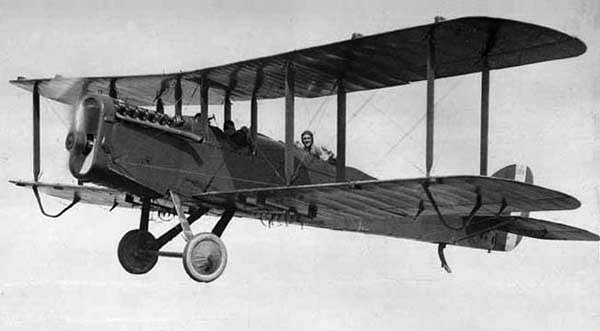
|
A First World War British bomber,
the Airco DH. 4.
During the last five months
of the War, British aircraft dropped a total of 550 tons
of bombs (including 390 tons dropped by night) on German
targets for the loss of 109 aircraft. |
The German nation was beginning to crack. Lack of food and the
casualty lists were causing and demonstrations throughout greater
Germany. Early in 1918 the German High Command launched an
offensive westward in the Somme area, pushing back our forces almost
to Amiens.
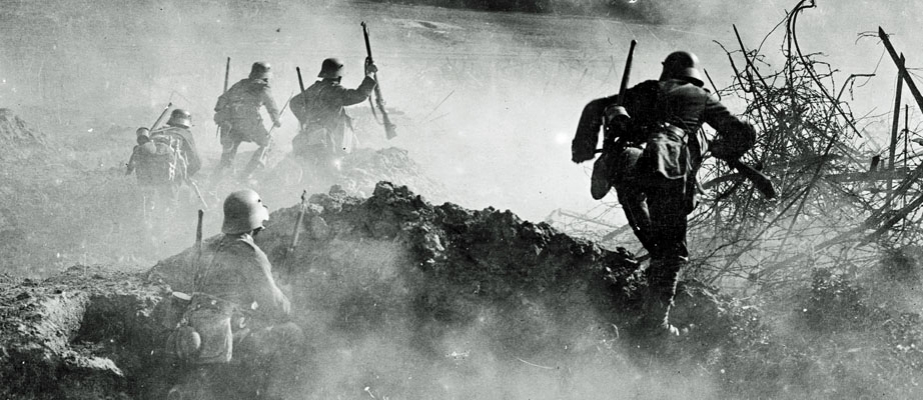
|
German troops advancing
during Ludendorff’s Spring offensive, March 1918.
Germany had the temporary
advantage in numbers afforded by nearly 50 divisions
freed from the Russian front following Russia’s
surrender. |
Food shortages and unrest was showing throughout Britain, very
similar to Germany. Socialism was surfacing taking heart from the
success of the Russian Revolution.
The Tring war memorial is nearing completion. It is hoped that the
unveiling and dedication would be held on St Peter’s day 29th June
1918. Due to various delays the memorial was unveiled and dedicated
on 27th November 1918.
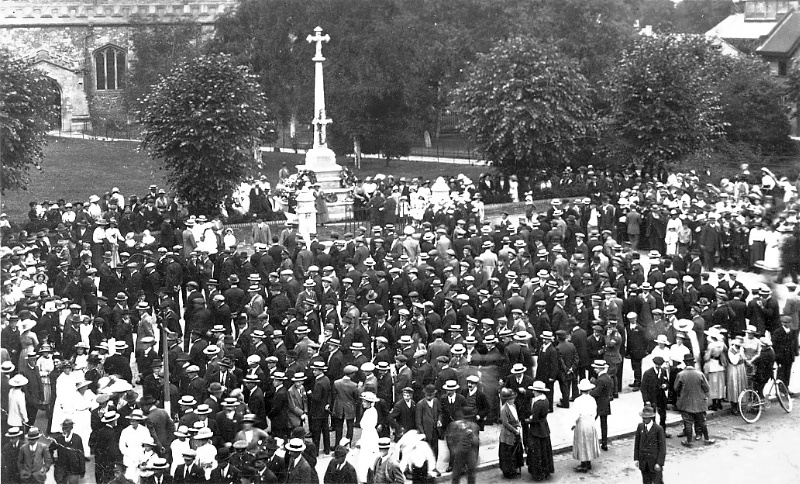
Thanksgiving
for Peace on Church Square: 24th July
1919.
The War Memorial is in the background.
The Parish Magazine for April 1918 published a letter from an
officer in the Royal Flying Corps in Italy:
“The other day I was at
--------- aerodrome, it began to snow, so I beetled back here as
rapidly as might be. The snowstorm put up a pretty good fight
but we beat it alright. But we had to go! Normally I fly
at 50-55 miles per hour, to ease the engine, but I saw now that I
should get a move on. So I started at 70 mph, and for the
first 10 miles kept level with the storm, which was about a mile
away. I could see quite clearly up to the south but then it
looked like a thick white mist. I said to myself ‘My child,
carry on at 80 mph’. But even at this pace the snowstorm
gained on us slightly. In the end we beat it by four fields.
I have been caught too many times by rain and muck to take any
chances by going slowly. These jiggers will do 105 mph near
the ground and I was flying at only 800 feet. It was quite
amusing and my engine was priceless.
I went up for a joy ride the other day to try the electric heating,
which I think I told you about. There is a 250 volt dynamo on
the machine driven by a small propeller 18" across, and a switch box
containing about eight switches. Three of these are for body,
hands and feet. For your body, you put on under your tunic, a
wash-leather waistcoat, which has resistance wires all over it.
For your hands you have thin cotton gloves, with wires down the back
of each finger. For your feet you have socks - the sort you
put in your boots when they are too big - these also have resistance
wires in them.
The other switches are: (1) for heating the guns to keep them from
freezing; (2) to power the klaxon horn used for contact while
flying; (3) for navigation lights, which are on the wing tips and
also behind the observer, and underneath the machine. (these are to
show who and where you are in night flying), (and also to prevent
being run into); (4) for charging accumulators for wireless; and (5)
for Holt landing flares under each wing for night landing, and are
fired by a hot wire.
When I got up I turned on the three body switches and everything
worked gorgeously. In fact, I had to turn the hands switch off
after a bit as they got too hot.”
Letter from a Royal Engineer (Signals) officer April 3rd 1918:
“At last! After
twelve of the most strenuous and exciting days I have ever known,
the remnants of us are safely out for a bit of green field, able to
sleep. Ever since the fight began we have been at it all day
and all night - fighting, marching, retreating, counter-attacking,
etc., etc.
Out of the twelve nights of the fight I was four nights without a
wink of sleep and have certainly not averaged three hours sleep out
of the rest of the twelve days. Never had boots off, except
once to wash my feet; shaved about three times; washed hands and
face about every other day; and with it all have been wonderfully
and marvellously fit - huge appetite and perfect digestion, walked
and ridden countless miles without fatigue or soreness; and come
right through it without a scratch. A most wonderful
experience!
Yesterday we came out of the fight battered and dirty but still
cheerful. I ended up by an all-night march of 24 miles, so
tired and sleepy that I could not remain on my horse, but had to
walk to keep awake, after which I slept all morning, most of the
afternoon, and all night, and could still do with more.
The Signal Company has been pretty fortunate on the whole in the way
of casualties, one officer killed and some valuable NCOs, but very
few men and only three horses.
When we are refitted we will, I suppose enter the fight with renewed
vigour. The end is not yet, and though the Hun has won the
first act, it does not follow that he has won the rubber. Our
post has been held up from the start but I have received it all
together yesterday.”
Bucks Herald, June 1918. Herts Recruiting Campaign for
Women on the Land:
“A recruiting rally for women on the land will be held in Tring on
Saturday, June 8th. A procession of land army girls and part
time workers from Tring and surrounding villages, decorated wagons,
etc, will start from the ‘Britannia’ at 6 p.m. and march through the
town to the market place, where a short open air meeting will be
held.
A letter thought to be from Lieutenant Kesley, published in the
Parish Magazine, June 1918:
Palestine
“I have been moved from camels to donkeys; the Corps is under the
same administration as camels, and is newly formed, so of course it
has to be officered, and I have been selected as one of them and
posted to No 1. It is really a big scream. I wish you
could hear the noise at feeding time. I have 500 of them, and
it is a regular Donnybrook! Of course, I am no longer on the
coastal sector and probably, shall have a chance of getting to
Jerusalem, which is about 25 miles distant, but the country is about
the worst I have ever struck. It is very mountainous with
hardly any cultivation, and the mountains are covered with huge
boulders of rock, and only donkeys can get about on them, with the
exception of goats. But they are not forming a goat corps yet!
We seem to be away from the world up here, away in the hills.
Everything is very quiet except for the hum of an aeroplane; it
seems almost living a hermit’s
life.
Later: At last I have seen Jerusalem. Just before entering the
city, Nebi Sainwil, the traditional tomb of the prophet Samuel, is
clearly visible from the road. This where some of the stiffest
fighting took place, and one cannot understand how our boys overcame
such strong positions; it was superhuman. I took a guide to
the Holy Sepulchre; there I saw our Lord’s tomb. The church,
which is built over it, is very beautiful inside. I cannot say
what passed through my mind as I stood by the side of his tomb, but
everything seemed to be at peace. I also saw the mosque of
Omar, the Jews’
waiting place, and the garden of Gethsemane. It is hard to
realise what happened here.”
June 1918: Letter from Guy Beech, Chaplain to the Forces, former
curate at Tring.
With a Middlesex Regiment Battalion B.E.F., May 3rd 1918.
“As the address shows you, I am now attached to the ‘Diehards’.
My last letter was written just before I left the reinforcement camp
to join the Division. Eventually I reached it close to the
town I had left the week before I was posted to this battalion whose
padre had been killed in the recent fighting. But how long I
shall be with it is uncertain, as it seems likely to be broken up,
which will mean my being transferred to some entirely different
unit. Most of the men have been drafted away, and their place
may possibly be taken by Americans. We have been perpetually
on the move from one village to another in back areas, quite a long
way from the fighting line. We are billeted in first one, and
then another French house; usually a farmhouse built four square
like an Oxford college quad, and usually with a refuse heap in the
centre!
In the last village my bedroom overlooked a pretty little valley
with an aerodrome on the opposite hill and on clear evenings I used
to watch the aeroplanes come out one after the other from their
hangars, like wasps from a nest, and go off in formation, laden with
bombs for the enemy territory. Here in another farmhouse, I am
roused at by the old French peasant starting forth with his plough
and horses for the fields. The French are indeed wedded to the
soil. Everywhere you see them working on the land, the women
and old men, and there they are from sunrise to sunset every day.
Doubtless it is one great reason of the strength of France, and one
can’t help wishing we English people loved the soil as they do.
We are under orders to move again tomorrow and have a seventeen mile
march before us.”
G.B.
An Economic View, published in mid 1918: IT CANNOT LAST.
Through one means or another many people are earning large wages.
Hundreds of firms are paying excess profits tax. And many
workers outside the big industrial world are receiving salaries and
wages, which, for purely war reasons cannot last. Thousands
are earning comparatively good pay, which they will take as a matter
of course until ‘their services are no longer required’. What
is to be the future of these?
There are two distinct types of worker: first, the organised wage
earner; second the new worker in office situations. The first
section, though quite aware that the war (and war prices also) are
liable to fall when peace comes, will look to the State to prevent
the dislocation and unemployment that have followed previous wars.
But a guarantee against actual want does not mean continued
prosperity. Even when a minimum wage is the rule it will be
far less than the present maximum. The second section is in
a position quite undefined. To both the National War Savings
Committee offer sound advice when they say, ‘Save while you can and
buy War Savings Certificates’.
Let us grant that the State would not allow wholesale
disorganisation and unemployment. But let us remember that the
State, like the individual, depends on trade. It is impossible
to guarantee high wages, for the so called ‘good times’ of war
depend on artificial causes. It is to be hoped that new trades
and fresh energy will flourish and abound. But behind such
hopes lies the plain fact that the men and women with £10, £50, or
£100 in hand will be saved an anxiety. For no state exists
that can restore to its citizens what has been lost or wasted, or
create wealth out of thin air.
It is not necessary to buy certificates one by one. £1
certificates are issued in book form; or twelve may be bought at one
time (on one certificate) for £9-6-0 and £25 certificates cost
£19-17-6 each. If you have any odd sum, you can put it all
into certificates in exchange for one document and you can withdraw
part of the money at any time if you need it. A small reserve
fund may make all the difference some day, between having to jump at
the first job that comes your way, and being able to wait until you
can secure congenial occupation. The certificates you buy
today may mark the turning point of your career.
Education: the Rev. Basil J. Reay, Diocesan Inspector of
Schools, paid visits to each of our schools during July and has sent
us most encouraging reports. From these we make the following
extracts, which speak for themselves:
“The school is in excellent hands, and the scholars are being
taught to think for themselves, with very good results. I was
particularly pleased with the way in which the bible narrative was
known, and with the clear evidence of the application of the moral
and practical lessons to the lives of the scholars. The tone
throughout the school was excellent”.
“This was an excellent school in which the scholars are being
very fully taught and where, not only is the knowledge imparted, but
the children are being encouraged to think. The staff are to
be much congratulated on the result of their care and instruction.
An excellent tone was apparent, and the keenness and bright
answering of the children was delightful”.
“The children have received careful and sympathetic teaching for
which they made, on the whole, an adequate return. Good work
has been done, and many of the children answered in an intelligent
manner. The tone and reverence was pleasing”.
“There was evidence in this school of careful teaching, and keen
interest on the part of the children; and in both classes, the
answering was bright and general”.
We are sure that all our readers who have a care for the well being
of the rising generation, will read these remarks with real
pleasure, and will congratulate those who have made it possible for
the inspector to make them.
August School Honours:
Boys: Kenneth H. Desborough has obtained one of two open minor
scholarships at Berkhamsted School. Francis Mildred has won a
County naval scholarship. John Lines, who passed the written
part of the examination, was disqualified due to defective eyesight.
Girls: Nora Lines has been elected to a free place scholarship at
Berkhamsted High School.
Our congratulations to teachers and scholars alike.
September 1918. The War Memorial: the total sum as estimated
for the erection of a war memorial: £450-0-0 has now been received
from public subscription. The cost of the wrought iron gates
is considerably more than first estimated, and it is expected that
more costs will be incurred, so contributions are still needed to
offset unforeseen costs.
Christmas and Tring men at the Front: the vicar called a
representative meeting of the inhabitants of Tring, at which it was
decided to send all of our men in the Royal Navy, Mercantile Marine,
Army and Royal Air Force, and those in hospitals will be sent a
postal order to the value of 5/-. A parcel, or money where it
is safe to send it, to the value of 10/-, will be sent to our
prisoners of war in enemy hands. Collections for this
enterprise, and names of entitled to receive this gift.
November 1918: on 11th November an armistice was signed, to
cease hostilities at 11.00 a.m. on that day. There was great
rejoicing throughout Great Britain.
An excerpt from the war diary of Mrs Ethel M. Bilborough, of
Chiselhurst, Kent: November 11 1918:
“I was trying to write a
coherent letter this morning when all of a sudden the air was rent
by a tremendous bang! My instant thought was a raid! But when
another explosion shook the windows and the hooters at Woolwich
began to scream like things demented, and the guns started
frantically firing all round us like a mighty fugue! I knew
this was no raid, but the signing of the armistice had been
accomplished! Signal upon signal took up the news; the
glorious pulverising news - that the end had come at last, and the
greatest war in history was over.”
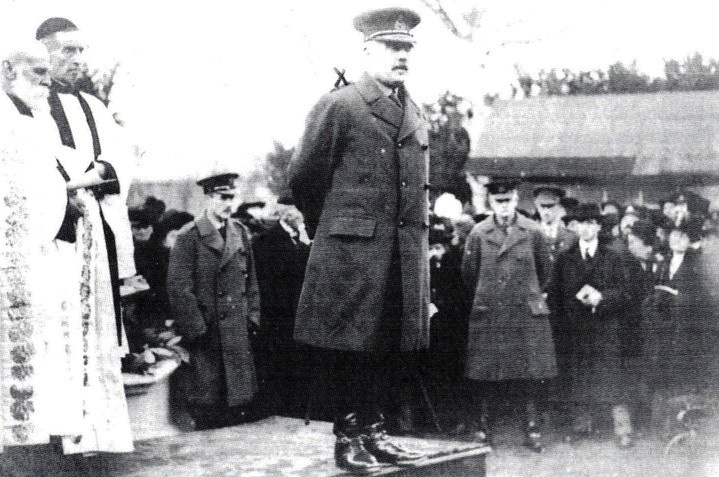
General Robertson
presiding at the Tring War Memorial unveiling ceremony
(Robertson remains
the only British soldier to progress from the rank of Private to
that of Field
Marshall).
The unveiling and dedication of the Tring war memorial was performed
on Wednesday November 27th 1918 on the Church Square at 3.30 p.m. by
General Sir William Robertson GCB, KCVO, DSO (General Officer
Commanding in Chief, Great Britain), who gave the address. The
memorial was then dedicated by the Very Reverend T C Fry DD, Dean of
Lincoln. |

The Treaty of Versailles Ends World War I, but
German resentment over harsh peace
terms leads to a rise in nationalist sentiment and the eventual rise
to power of Adolf Hitler.
In this painting is by the Irish artist William Orpen,
President Woodrow Wilson (United States - holding papers),
and Prime Ministers Georges Clemenceau (France)
and David Lloyd George (Great Britain), are seated centre.
|
1919.
The Treaty of Versailles was signed on 18th June 1919 so ending the
Great War. A national day of rejoicing was set for 19th July.
However this date was brought forward to Sunday 6th July.
This, of course, caused some confusion, however all went well on the
day. The festivities started with a short service on the
Church Square at 11 a.m. followed by festivities in the park.
A good time was had by all.
――――♦――――
THE COUNCIL
Written by Bob Grace, Tring Councillor.
In the local paper in December 1894 there appeared a tribute to the
Local Board of Health written by Mr J. T. Clement:
|
“Farewell old Local Board, farewell
Thy end is drawing near
But ere the fatal moment comes
Hear thee a word of cheer” |
The writer goes on to give a factual but light-hearted account of
the work done by this forerunner of the T.U.D.C. [Tring Urban
District Council] In this very short note on 79 years of
Local government, I have tried to follow Mr Clement’s lead, alas not
in verse.
|
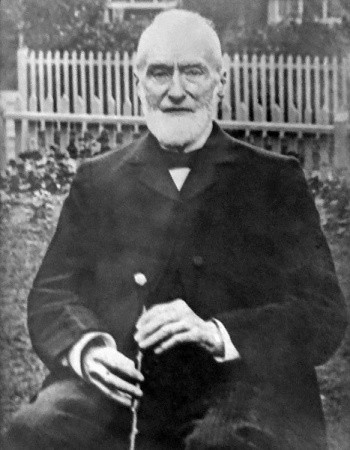 |
|
Frederick Butcher
(1827-1919). |
The first [Tring Urban District] Election in December 1894
had been well contested and Mr Stevens, Boot and Shoe Maker, topped
the poll, he being a very respected townsman, always available to
help with your problems, and a Baptist lay preacher of note.
At the first Meeting (3.1.95), Frederick Butcher, local
Banker of Frogmore, member of H.C.C.
[Hertfordshire County Council] was made Chairman. The
Hon Walter Rothschild (later 2nd Lord), M.P., was also a member.
Glancing through reports, no doubt these great bankers gave their
careful consideration to the Granting of a Pawnbroker’s Licence to
Mr Seabrook and that Mr Attwell of the Red Lion could hold a Lodging
House Licences for his 1/- a night boarders; the first Rate of 2/6
in the £ brought trade to Mr Seabrook.
Under Mr Butcher’s Chairmanship and the guidance of Mr A. W. Vaisey
as Clerk (salary £125.0.0d per annum) the monthly meetings were
referred to as a “Duet with Occasional Chorus”. Health was and
still should be the prime duty of Local Government. At this
period Scarlet Fever and Diptheria epidemics were rife and the
building of the Little Tring
Hospital was an enormous boon to the Town. In 1902
Smallpox was endemic and patients were housed in a tent at Aldbury –
to quote Mr Clement:
|
“But human faces marred and scarred,
Eyes darkened, long have been
Things of the past, for rare now
Such saddening sights are seen.” |
This plague was still with us. By May 1903 the Matron of the
new Hospital felt that after eighteen months’ work she might ask for
three weeks holiday, which was promptly refused, but she might take
14 days on the understanding that she returned if a patient was
admitted.
The Station Road, which had had ruts three feet deep, had now been
surfaced with flint, with the aid of a steam roller. The
Landlord of the Robin Hood was sent a bill and strong letter for
having managed by diplomatic means to get the roller to rolls his
yard without the surveyor’s knowledge! The Council felt that
the Station bus should now be able to meet the trains and as it was
failing to do so, consideration to a take-over almost succeeded.
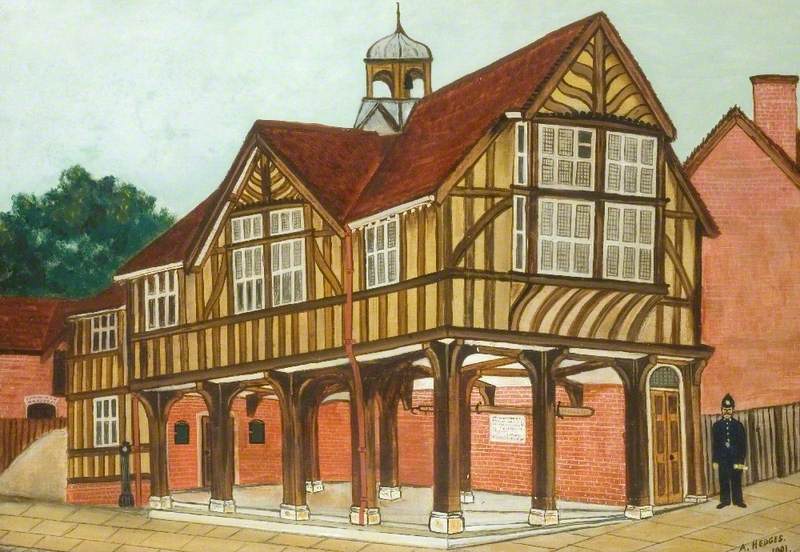
The New Market House, High Street,
Tring,
by A. Hedges (1901).
|
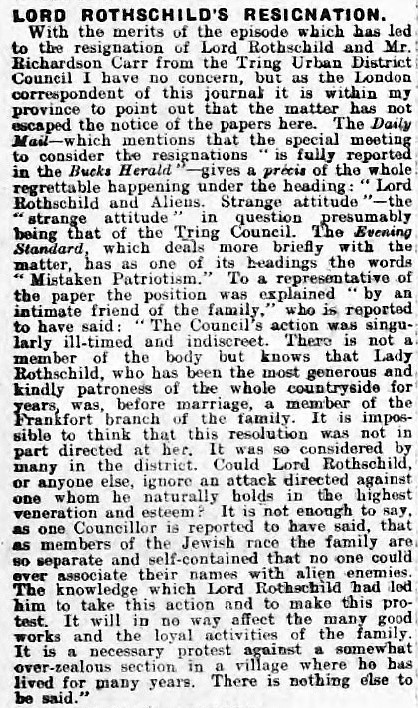 |
|
Bucks Herald, 24th
June 1916 |
Meetings were held in the market house in the room which had been
designed as the Market Hall and Corn Exchange. Members
complained of cold feet and in 1910 the ground floor was enclosed
at a cost of £90.0.0d. Heat was, however, generated when the
Surveyor, who had to cover the 25 miles of district roads, asked for
£5 per year bicycle allowance, which was allowed by a small
majority, but the request for a telephone at £5 per year with all
local calls free was immediately refused. Refuse collection
was late and uncertain and was only able to continue when Cllr.
Rothschild used his good offices to get permission for the ash carts to tip
[refuse] into the
disused canal at Little Tring. Traffic through the Town
now came in for attention and 1911 saw a request for a Motor Speed
Limit. This was eventually granted from Langdon Street to the
Rose and Crown. At this time it was possible to buy milk at 11
dairies and milk shops; bread from 12 bake houses; meet from 7
slaughterhouses, and to work in 26 factory premises. 616
children were at school. Death rate 15.3 per 1000 – Birth rate
18 per 1,000 – BUT death of infants under 1 year, 61 to 1,000
births! If since 1912 the Council has helped to bring this
figure to Nil in 1972-73, it has justified its existence.
The 1914-18 War did not miss Tring. Rate relief was allowed
for houses
given over to Belgian refugees and its hospital, schools and hall
became Tring Military Hospital, which in 1915 was receiving patients
from the Dardanelles. The writer would have voted in support
of a request from the School Managers for “Better heating at Church
House and Market House, now used for the school”, for during the last
winter the temperature did not exceed 40ºF on many days (I remember
trying to sit as near under a gas light as possible with my overcoat
on). Council, however, became very heated and passed a
resolution that “All aliens be imprisoned or deported” – this
was in bad taste to say the least, considering the position of the Rothschilds and their employees, many of whom came under this
heading and in many cases were fighting in the Allied Forces.
Lord Rothschild and the chairman of 16 years standing, Mr Richardson
Carr, resigned immediately! On the reverse face, however, a
move to mark the award of the V.C. to Edward Barber was voted “No
Action”.
|
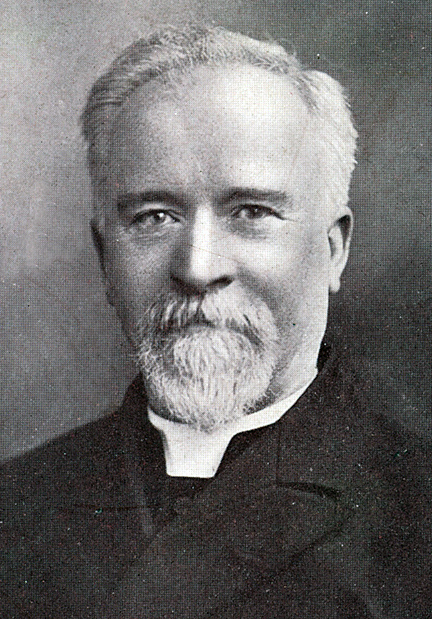 |
|
The Rev. Charles
Pearce. |
The next Chairman, Pastor Charles Pearce, spent weeks
visiting as many wounded Tring men in hospital as possible and the
Council agreed to tend the graves of the fourteen soldiers who died
locally and are buried in our Cemetery.
The price and scarcity of meat caused public concern and the Council
set up a Food Control Committee. They tried without success
to stop animals sold in Tring Cattle Market leaving the town; they
also failed to stop Council workmen leaving to work at Halton Camp
for 10d. per hour! The Armistice was greeted with the public
demand via Sir Steven Collins, M.P. for a ‘War Trophy’. This arrived
in the shape of a very old German Gun, which appeared never to have
been able to fire. From its place of honour in the Market
Place it was moved to Miswell Lane Recreation Ground from where it
was quietly sold for scrap metal! The further gift of an
ex-service ambulance was refused owing to the cost of a garage and
insurance.
|
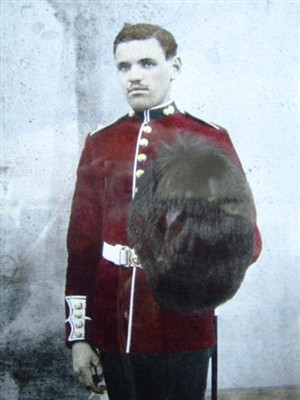 |
|
Private Edward Barber
(1893-1915) V.C. |
1918 brought the great Influenza Epidemic and Health properly took
precedence over business. The surveyor was instructed to get the
ventilation improved in the Empire Picture Palace, Akeman Street.
Prices came under examination and seven members formed a
Profiteering Committee. There is no report of anything being
done at a stroke, but as is usual a Coal Strike followed and all
the gas street lights were
extinguished. Two
lamp-lighters were part-time employees and it was decided not to pay
them even half wages for the strike period.
A report that boys were playing football in Miswell Lane Recreation
Ground on Sundays was passed to the Police to stop it. They
refused to take any action. It was then forwarded to the
Ministry, who in those days could give a definite answer in return,
which again was No! Further complaints from Miswell Lane
concerned an industrial site, where sausage skins were processed –
this time the complaint was smell rather than noise!
By the mid-twenties leisure appeared on the agenda and the need for a
swimming pool was noted. Next the Education Committee added
their pleas for it and within ten years a Swimming Pool Committee
was set up. The first application to set up the County Library
in Tring was turned down “As against the interests of shopkeepers”.
However this was reversed at the next meeting and, to rub the result
in, the books arrived on a Sunday! The library had to be run
entirely voluntarily and a payment of £2 paid by the Council
was overruled by the Ministry and had to be found by public
subscriptions. By 1928, 648 people were on the list and 473
books were permanent. In 1932 it was allowed to pay a
Librarian £13 per year on the condition that it opened two
nights per week, the approximate lendings being 250 per week.
In 1936 the books were turned out of Market House to the Junior
School in the High Street. In January, 1937, Mr. Thomas Grace was
appointed the Chairman of the Library Committee, a post he held
until its last meeting, with at least one other member who has been
on the Committee becoming the Council’s longest serving Committee
Chairman.

|
Photo courtesy of
Mike Bass.
Besides being a
long-serving town councillor and a well known local historian,
Bob Grace (author of this account) was famous in the locality for
his lantern slide shows. |
In 1928 the Health of the town was again to the fore. The
Surveyor reported over 70 cases of overcrowding and, to the M.O.H [Ministry
of Health], that 34 houses were unfit, some of which had been
condemned in 1914 (one or two remain today). Many children
from these homes who attended the Council School were suffering
from T.B. [tuberculosis] and Ricketts. He reported that
the tenants of these houses could not afford more that 3/- to 5/- a
week rent inclusive. The Council, who were refused Ministry
help, could not rehouse these people and a voluntary scheme was set up at New Road, the houses being
built by a public appeal headed by Chairman John Bly. One man
without a home found to be living on his council allotment was
ejected as a trespasser. With all his extra Health work the
Surveyor asked to have a typewriter, which was firmly refused,
as was the public’s request to be able to pay for the newly laid-on
electricity in the Town. It was, however easy to reach
Aylesbury to pay; Premier buses ran every half hour, Viking express
coaches at the hours, Chiltern buses if required.
The Council received complaints that people were shopping out of
Tring and tried to get the licences of the buses reduced, but by
1934 the L.P.T.B. [London Passenger Transport Board] cut all
services to one per hour and did not connect with the trains.
Only after many meetings was some improvement made. It was, however,
possible still to use the Canal. 76 boats were Tring
registered, eleven being motor. Road traffic was causing
concern and in October 1932 the County Surveyor was asked to improve
Cow Lane to the London Road junction, and two months later to consider
traffic lights at the Akeman Street/Frogmore Street corner. By
1935 the Council was refusing a pedestrian crossing in High Street,
and the Road Safety Committee placed their resignation en block
in the hand of the Council to try to get the crossing, which did not
come until some thirty years later! Town Planning was not a
council power in 1933 but it was agreed to do all they could to
oppose the setting up of a Motor Race Track at Folly Farm on land
which, when this was refused, was bought to set up the Cement Works.
It was refused to signpost field paths but it did, however, under
pressure from the Surveyor, draw up a map of all the known rights of
way!
In 1937 a joint Planning Committee with Berkhamsted U.D.C. and R.D.C
drew up a Town Plan and recommended an industrial area between the
Station and New Ground. Green belt areas were agreed and the
purchase of the Woodlands pressed forward by Chairman Donald Brown
M.C. He had the difficult task to prepare for War. An
A.R.P. Committee was formed, and First Aid etc., was instructed by
Cllr. Kettle, at first with little support, but the report to the
Council, October 1938, that Air Raid Trenches had been dug at
Miswell Lane, Dundale Road, near the Brittania, High Street and the
School, brought the threat home and work really started.
With the arrival of evacuees requiring another Committee, which was
most unpopular, and in September 1940 the first bomb brought War to
Tring!
When Victory came, the Clerk reported 1,152 Red Warnings, 15
incidents, 36 High Explosives, 2 Land Mines, 1 Oil Bomb and a number
of incendiaries, 162 houses damaged, no-one killed or injured,
although the incidents included air crashes in which Service
personnel died. V.E. day had been celebrated by street parties
but proposals to welcome home members of the Forces failed to get
enough support, except to send most a pocket wallet.
However, a new Committee of Townspeople was forming, that of the
Ratepayers Association (now Residents) and at the next Council
Election they won all the seats. From this date, a study of
the Minutes of your Association gives a picture of Council
proceedings in which the writer has pledged some part and I will not
comment further.
To again mis-quote Mr Clement:
“So cheer up then thou U.D.C.
As now they labours cease
May you now rest in peace!
Tring then in future years may be
A place of just renown
By ‘Dacorum’ wisely ruled,
An Almost Model Town!” |
R. G. Grace.
――――♦――――
TRING FIRE SERVICE
This piece (author unknown) appears to have been written in the
1970s. |
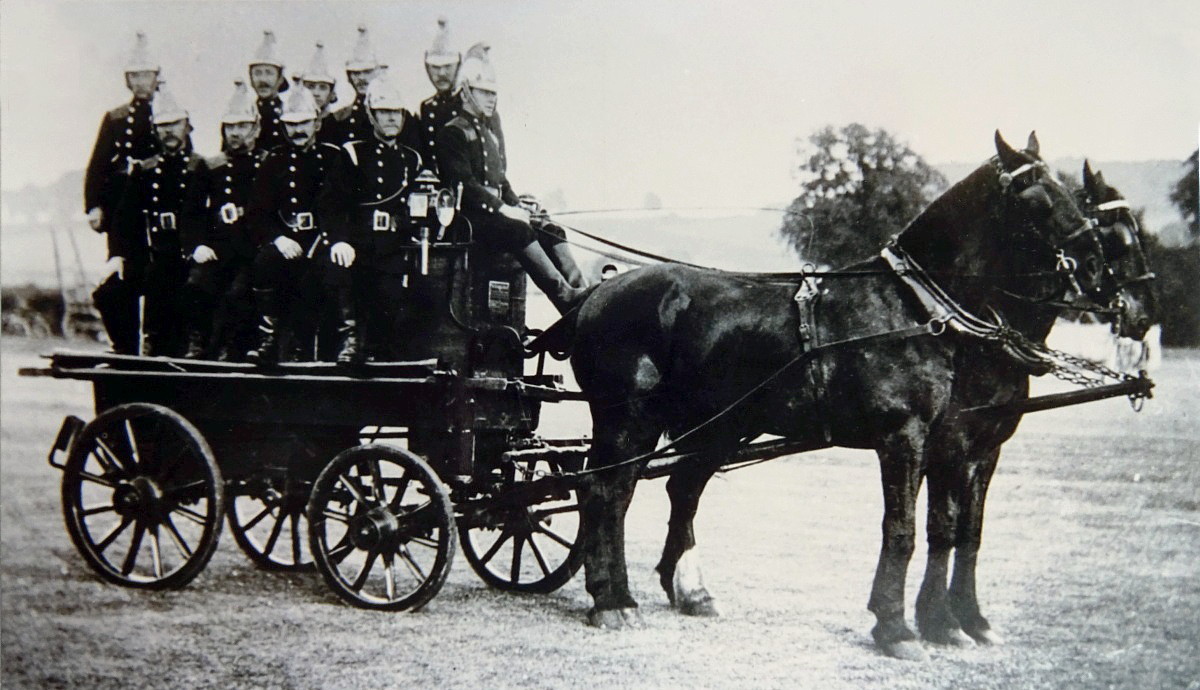
|
Tring Fire Brigade posing
with their horse-drawn fire engine, which remained
in use for almost
two hundred years before being replaced in the 1920s.
Spare a thought for the apparently impatient driver behind you next
time you are in a queue of cars in Tring High Street. Don’t
discount him as another menace soon to be removed by the opening of
the by-pass [opened 1973]. He could be one of Tring’s
vital citizens and one day you may be thankful that no queue of
traffic impedes his journey.
Why? Well he could be driving Tring’s fire engine. Tring
Fire Station is manned by thirteen able-bodied part-time officers,
three of whom live and work in Tring and are thus on permanent
standby. A fire alarm these days is not sounded by the old
-fashioned siren. Electronic wizardry provides each fireman
with a personal alerter which operates within a five mile radius.
These have been available for three years and although more
expensive are much appreciated by the neighbours of the siren tower.
A radio signal from Divisional Headquarters triggers a device at
Tring Fire Station. This transmits another radio beam which
when received by the alerters causes them to emit a buzzing alarm.
It is then down tools and off to the fire station with grateful
thanks for an understanding employer.
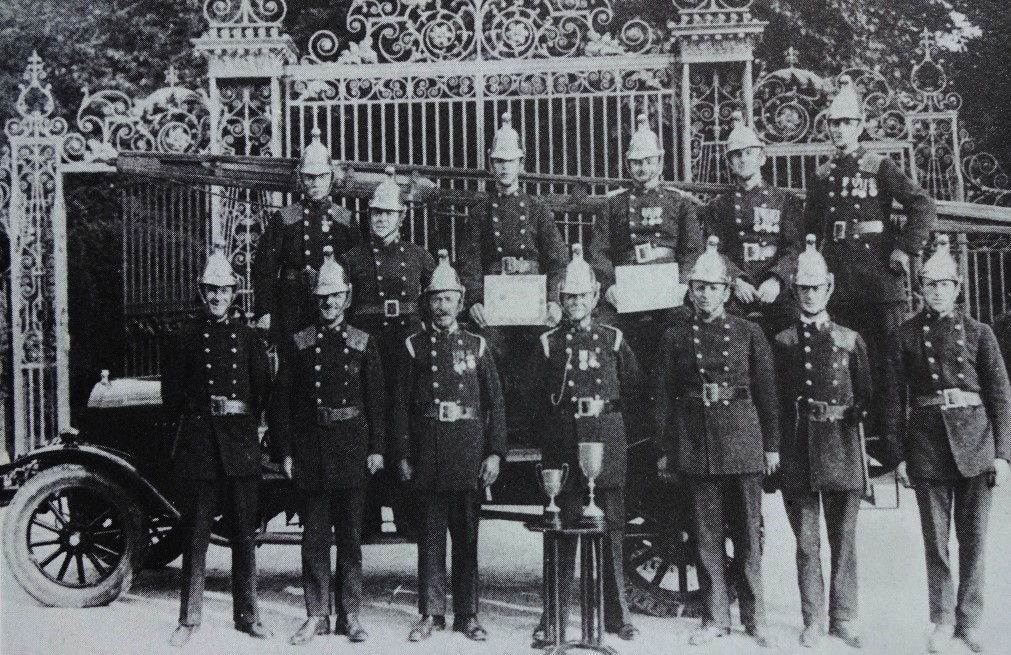
The Brigade with Tring’s first
motor fire engine. It was so under-powered
it could not climb the hill to Wigginton.
The staff of the station – in official jargon it is a Retained
Station – come from various walks of live. The occupations
they hold include a painter and decorator, printer, farm worker,
factory foreman, electricity board worker and security officer.
They are led by a Sub-Officer Gosling, and to help him in his work
he has two leading firemen and ten firemen. This band of volunteers
cover a wide area round Tring, including Wigginton, Pitstone, Hastoe,
Cholesbury and Aldbury. During the day only three men work within
range of the alerters, but at night all thirteen can be raised by
this system. It is the first seven at the station who go out on
call, six to man the fire engine and one to remain on watch at the
station; not surprisingly this latter job is the less-favoured of
the jobs. These men enjoy the thrill of not knowing what they might
be going to deal with when an alarm comes. The type of call can
range from a simple chimney fire, involving no mess with modern
equipment; to pulling a donkey out of the canal. The firemen can
cope with all types of calamities including flooding, grass fires,
motor accidents and even light aircraft crashes. The fire engine, or
pump, is modern, with a 400 gallon tank of water and a 35 foot
extension ladder. It also carries breathing apparatus, equipment to
deal with chemical spillages from lorries winches and of course a
two-way radio.
Tring Fire Station had at least one hundred calls a year, with
happily few false alarms. The men are proud of their record of a
four minute turnout to any call, and that includes travelling from
home to the station. If you have volunteered to be woken at anytime
of night after a hard day’s work, with the knowledge that you have
to be in the next day at work after a call, you would expect some
financial recompense. Payment these men get, but hardly worthy of
the task they perform is £1.95 per turnout for the first hour, which
after tax deductions, and if a daytime call-out also loss of working
hours which have to be made up, leaves a fireman with little
compensation for his trouble. But it is just such dedicated men who
provide you with the security of help when you dial the triple nine. |
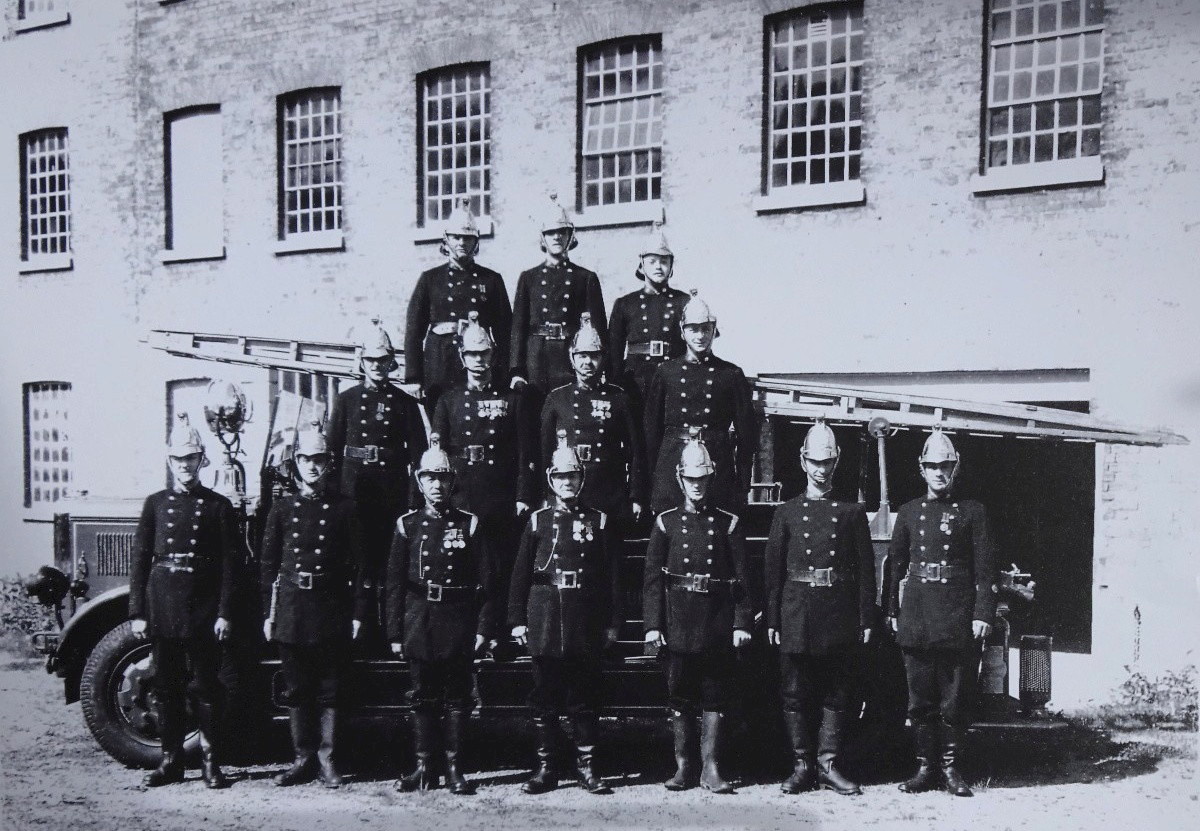
|
Tring Fire Brigade with their
new Leyland fire engine outside the Silk Mill (c.1930s).
――――♦――――
ALL BECAUSE THE FIRE BRIGADE WASN’T THERE?
by Denis Aldrige, May 2000
There had been a fire at Spencers Green in January 1926. The
Tring Fire Brigade had not attended. Members of Tring (Urban
District) Council wanted to know why the alarm bells had not been
rung; who should have rung them; and why had no effort been made to
go to the fire. In other districts the police rang bells to
alert members of the fire brigade. In Tring the police had to
notify Mr Gilbert Grace who maintained the alarm bells in his house.
On this occasion the police had notified Mr Grace who had then
consulted Mr Putnam, Captain of the Brigade, who was nearby.
The Captain decided not to attend the fire because he believed that
the brigade’s hose would not reach the nearest water supply (at Ebbs
Pitt Pond below Dancers End) and he was sure that the Aylesbury
brigade had a longer hose and could get there more quickly with its
motor engine.
Tring police had notified Aylesbury and the Aylesbury appliance had
indeed got to the fire quickly and had dealt with it satisfactorily.
Nevertheless councillors regretted that Tring Brigade could then, at
least, have offered to help the Aylesbury men. In fact, there
was no certainty that horses or firemen were available in the town
during the working day. Cllr Goddard contended that seven
firemen had been available. But that was not known at the
time. Moreover councillors were aware that when a serious fire
broke out in Mr Howlett’s bakery on an afternoon some months before
only one fireman was to be found and the building had been badly
damaged.
The immediate result of the Spencers Green fire was that Tring
Council unanimously decided that its fire engine and hose cart
should be fitted with drawbars to enable them both to be attached to
a lorry. Two firemen were to travel on the fire engine to
control it and the remainder were to go on the lorry — Messrs Gower,
Prentice and Rolfe agreed to allow their lorries to be used for this
purpose. — The Surveyor was also asked to look out for a more
up-to-date, second hand engine and for motor pumps on sale.
The captain of the Brigade took umbrage at the implied criticisms of
his actions and gave notice of his resignation with effect from 31st
March. This distressed the Fire Brigade Committee which
promptly passed a resolution expressing its confidence in Mr Putnam
and asking him to reconsider his decision. The Captain was
only prepared to do so if the Council would agree to provide the
Brigade with adequate equipment. The Committee immediately
asked him to draft a list of requirements in order of priority (lest
the Council would not agree to buy everything at once).
A rick fire at Church Farm, Marsworth on the evening of August 7th
concentrated councillors’ minds still further. After the fire
alarm had been sounded in Tring “a large crowd assembled outside
the fire station and cheered ironically when the Brigade eventually
got away alter a long delay -- due partly to the fact that the
arrangements for hauling the fire engine with a lorry and drawbar
attachment did not work very smoothly ...... the new method was
tried because of the difficulty in getting the engine horsed.”
On arriving at the fire there were further problems. The
engine had not been used for some time so the leathers were dry, and
for a while only “a tantalising trickle of water could be pumped.”
Nonetheless the Brigade was able to save much of the 21 ton hayrick
and prevented the fire spreading to farm building and to two other
ricks.
The Council had already invited surrounding parishes to join a
contributory scheme for the provision and maintenance of a new
engine. By 24th January 1927 it was plain that the surrounding
districts had no wish to contribute. Tring Council hoped to
provide £600 from the next budget but that would not meet the cost
of a motor fire engine and the other appliances in the Captain’s
report of March 1926. The Fire Brigade Committee considered
the town to be well equipped with hydrants so it decided that a
motor fire engine would be an unnecessary expense and suggested that
the Council should buy a lorry instead. However, early in
March 1927 the Council accepted an invitation to inspect a motor
fire engine at Woodbridge in Essex on the understanding that they
were not committing themselves to buying one. At the end of
April, still not convinced by the demonstration, the Fire Brigade
Committee wanted a demonstration at the various hydrants in Tring
both with and without the engine. The Council Chairman was
certain that Tring did not need a motor engine and that it was
premature to allocate £600 before they knew what support surrounding
villages would give. At this point, the Council turned its
attention to a letter from Mr Grace inviting it to buy “the
electric alarm bell, switches, batteries, wires, installations etc.”
installed by his father. These items had cost about £50 but he
would be happy to sell them for £25. At that point it was
decided to buy a “half horsepower one mile radius siren” and
eleven 50 foot lengths of hose to the annoyance of Mr Bly who
considered the siren to be a great waste of money. It would
cause a commotion in the town and would not be necessary if they
possessed the bells as well.
Cllrs Goddard and Hedges had grown impatient with the delay.
By mid June I927 the Council still had not been able to secure a
demonstration in the town; only Portslade Council had responded to a
questionnaire on the efficiency of the (Baico-Tonna) engine being
considered; and surrounding villages had not indicated any
willingness to contribute towards the cost. However, Cllrs
Goddard, Mead and Rodwell persuaded the Council to place an
immediate order for this type of machine from Pemsel and Wilson of
Boxmoor. Anxious to reduce the burden on Tring ratepayers,
councillors also agreed to ask for a donation from “certain fire
insurance companies”, from Wigginton, Aldbury and Puttenham, and
for a loan from “the Ministry” to meet a total cost of £600
-- £451 for the fire engine, the remainder for appliances.
The Public Works Loans Board turned them down as “the purpose for
which the loan was required did not come within the class of loans
for which the Board had power to make advances”. It was
the Ministry of Health which approved the raising of a loan of £550
for the Council’s purpose. The villages still showed little
sign of contributing but the lack of their support was only going to
increase the Tring rate by ½d
so in the second week of September 1927 the Council agreed to
continue with the current procedure of simply charging a fee to
cover the cost of call-out to a village fire. Councillors also
agreed to increase Brigade personnel by two or three.
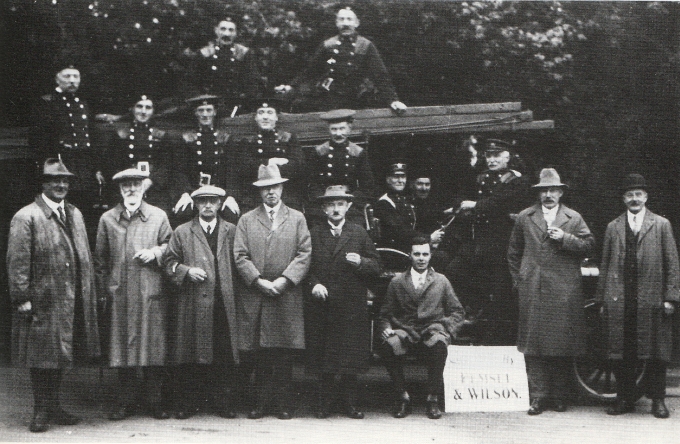
12th October 1927 -
official reception of the new Baico-Tonner motor fire engine.
Messrs Pemsel and Wilson brought the new machine to Tring for
testing on October 12th. It certainly pumped satisfactorily
but it could not get up Marlin Hill and needed several attempts to
reach the top of Hastoe Hill. Dispute then arose between the
Council and Messrs Pemsel and Wilson as to the merits of a low speed
axle and a gear box to remedy the problem. The axle would have
reduced the appliance’s speed to 16 - 18 m.p.h. from its existing 35
- 40 m.p.h. Agreement was finally reached on November 7th.
The firm gave a guarantee that with the gear box fitted — without
further delay and at a cost of a further £17-10s-0d -- the fire
engine would get up any of the hills in the district fully loaded.
The offer was accepted and on December 10th 1927, just a month short
of two years since Tring Fire Brigade’s failure to go to Spencers
Green, the Council received confirmation from the Fire Brigade
Committee that the motor fire engine had indeed carried the men and
full equipment up Hastoe Hill, Marlin Hill and Oddy Hill several
times. Councillors immediately agreed that a cheque for
£476-2s-5d should be despatched to Messrs Pemsel and Wilson.
Whereupon Cllr Bagnall referred to unfair reports which had been
circulated and asked the Press to take particular note that on
November 26th “under conditions none too good as regards weather
and roads, and from a cold start in the fire station” the fire
engine went up Marlin Hill to the Hastoe cross-roads in nine minutes
with full equipment and seven men, and then went from New Ground
Waterworks up Hemp Lane to Wigginton Church in six and a half
minutes.
――――♦――――
THE FIRE BRIGADE
by Jill Fowler, July 2013.
Until well into the 20th century Tring firemen would attend a fire
with a cart pulled by horses. This was said to have been
bought by the vicar and church wardens in 1750. In the 1890s
and early 1900s the horses were usually provided by Mr Gower who had
a removal business. There would be frequent reports of fires
in Tring, many of them chimney fires. One more disastrous fire
was in the hard winter of 1895 when Lord Rothschild’s Home Farm in
Park Road was completely destroyed. Due to frozen conditions
water was not readily available. The captain was Mr Gilbert
Grace from the High Street hardware shop and he led the fire brigade
until shortly before his death in 1914.
Mr Gower eventually changed to a pantechnicon for his removals and
sometimes the horse cart would be pulled by a lorry. The
Bucks Herald of September 11th 1926 reported, under the title of
“Motor Fire Engine”, “Surrounding villages are to be asked
to contribute to a new engine, the other one, now pulled by a lorry,
being completely out of date.” The new fire engine was
soon to prove its worth. The Tring Gazette of 1928
reported: “The provision of a motorised fire engine at Tring
proved to have been fully justified when the brigade fought a blaze
at The Grove. The speed of its arrival enabled most the furniture to
be saved, whereas the whole house would have been burned by the time
the old horse-drawn engine had arrived.”
For years the Fire Brigade was housed in the Vestry Hall near the
church. An early photograph shows the firemen standing in
front of the door with “Fire Engine” in large letters above
them. When the new Market House, on the corner of the High
Street and Akeman Street, was completed in 1899 it replaced the old
Market House that stood in front of the church. The ground
floor was open to supply easy access to the stalls.
Ten years later it was decided that the Vestry Hall was too small
for the fire brigade and plans were made to convert the Market House
for it. The work was completed in the autumn of 1910.
Many older Tring people remember the sound of the air raid siren
wailing from the top of the building and the firemen running down to
man the engine.
There were two major fires in Akeman Street. In 1965 a fire,
said to be caused by a grain dryer, destroyed a large grain store
and drying machinery at Bob Grace’s mill. Luckily the firemen
prevented the fire from spreading to the historic mill, now known as
Graces Maltings.
Ten years later there was a serious fire at Rodwell’s bottling
factory. Firemen fought all night to control it, with six fire
engines in all, from Tring, Berkhamsted, Hemel Hempstead and
Aylesbury. They were most concerned that the fire might spread
to the nearby Natural History Museum. The cause of the fire
was unknown, but most damage was done in the storage department
which housed a great deal of sugar. The bottling department
was able to carry on as usual.
A sad fire was in 1994 when Grace’s 240 year old Parsonage Place
barn, thought to be the oldest in Tring, was severely damaged.
It was said to be arson and a 17 year old boy appeared at Hemel
Hempstead Magistrates Court charged with starting the fire.
Eventually, as fire engines became larger, it was necessary to have
a purpose built Fire Station in Brook Street. The ground floor
of the Market House has now been “re-opened” and houses a shop.
In the early days a lot of the firemen , all volunteers, were
business-men, able to leave their premises at a moment’s notice when
the alarm was raised. They would have been amazed at the fire
engines and equipment available today, but their devotion to their
job, in spite of their difficulties, earned them the respect and
gratitude of Tring people.
――――♦――――
WRITINGS OF FRANK JOHN BLY, ANTIQUES DEALER
The first fourteen years of F.J.B
From the local broadsheet or weekly newspapers a notice - “On the
First of December in the Year of Our Lord 1904, Letitia Bly of 22
High Street, Tring was safely delivered of a male child.” No doubt
this was further repeated at the Baptist Chapel on the following
Sunday where Letitia and John were members, if not from the
Pulpit then certainly from mouth to mouth that “Lettie Bly had a
boy”.
After a short interval a visit was paid to the Registrar of Births,
Marriages and Deaths, and there recorded that one Frank John Bly, son
of John and Letitia Bly, was born on 1.12.1904.
I really remember nothing of the first five years of my life - not
in any real detail - but this I do remember, in 1909 a running
battle started between my dear parents and myself that was to last
for nine long years - I was taken to school.
My first kindergarten was with a lot of other boys and girls whom I
rather liked - or wanted to like - under the tuition of two rather
dear - and to me very old - ladies, the Misses Francis and Daisy
Collins at Elm House, Tring.
According to the
financial means of the parents, education in Tring in my young days meant
that boys went either to the National
School (Church of England plus County Council Aid), the Tring
Commercial School (a private establishment run by Mr Walter Edward
Wright) at White House Tring, or to Berkhamsted Grammar School. My
father chose the middle course, so off I went to Tring Commercial
School. It soon became quite apparent to everyone that I should
never win a scholarship to the Grammar School, so I remained under the
care of Mr Wright until reaching the age of fourteen. I have no
complaint about Mr Wright. He tried, and so did I, but we were
parallel lines; our ideas just didn’t meet. There were so many
things I wanted to do in my father’s workshop, the horse to be
groomed, the motor to be cleaned, anything rather than books.
But
less than a month after leaving school I knew I had been wrong.
Study I must, and study I did, and it’s taken possibly all my life to
make up for lost time. But my boyhood days were wonderful. In my
father’s workshop - a building about 200 yards from the shop -
were Mr Good, upholsterer and polisher; Mr West, cabinet maker; Williams Bradding, a young man doing all the odd jobs; and Lew
Crockett, the groom and general do-it-all.
Mr Good always said I was a “tiresome, interfering and meddlesome
child” (his favourite expression was “don’t meddle boy”). As an
upholsterer he always took a handful of tacks and while working held
them in his mouth. I found a few drops of paraffin dropped in his
tack tin cause him some slight discomfort, which helped me put up
with his meddlesome ways. But I learned a lot from Mr Good.
He was
a man of great patience and long before I left school he had
taught me to straw web a chair seat and hand stitch a hair stuffed
‘roll edge’ on a Georgian stuff-over chair – but I never did put the
tacks in my mouth, just in case!
Mr West always had all the tools I loved to use and from him I
learned at a very young age how to use them – I’ve still got scars
on my hands where the chisels slipped to prove it! But again,
before I left school, I had learned to know one piece of mahogany
from another; French walnut from English; how to iron down veneer
and cut bandings; and cut and shade in hot sand oval shell inlay.
Maybe I was wrong, but to me time spent learning in the workshop
was better than sitting at a school desk.
|
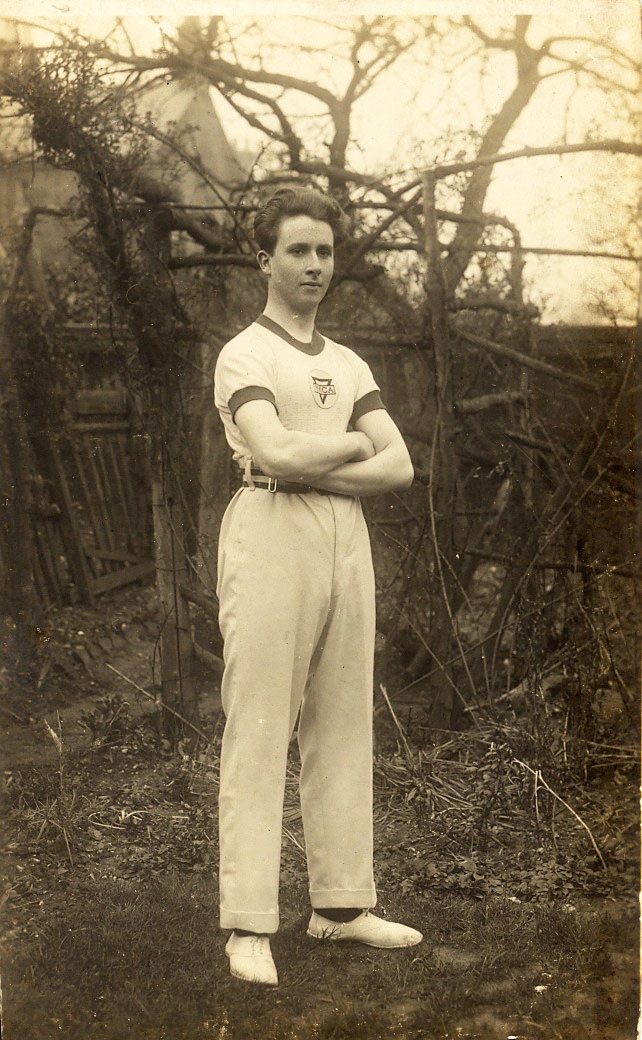 |
|
Frank Bly |
William Bradding, being younger, joined in everything. Our workshop
was heated by an old iron circular ‘Tortoise’ stove, its pipe going
through the wall into the fireplace and chimney of the next showroom.
One late winter evening, Mr Good and Mr West having gone home,
the stove fire had gone out. To restart it we poured some paraffin
on to the hot coke. This didn’t flame but must have turned into gas
because when we put a match to it, it went with a terrific roar.
The stove didn’t move, but a large wardrobe in the next showroom
did, and the hole in the ceiling where the chimney stack
came through the roof left no-one within a quarter of a mile in
doubt that something had happened. Father soon arrived and it was
our first ‘black and white’ show – I was black with soot and father
was white with worry and rage, although he was relieved to find us both alive.
All was forgiven, except for suitable punishment.
I’ll come to Mr Crockett later, but the only one in
the workshop, or anywhere else for that matter, was my father. He
could do everything. To me he was ‘all things to all men’ apart
from being a master craftsman in the workshop, a keen student of
many subjects, a fine judge of English Furniture, an outstanding
dealer, a great teacher and, above all, a wonderful father. He
could make the best rabbit hutches, pigeon cotes, railway stations,
build the best boats and chests for birds eggs.
To my father and mother I was always known as “the boy”. I can
never remember hearing my father swear, but whenever - and it must
have been on hundreds of occasions when I did wrong, or annoyed him
- he said “drat the boy”, into the word “drat” he could get
more feeling, more expression and wrath than any other word I have
ever heard. If it was in the morning, then one “drat” would
cower me for the day. But father practiced what he preached; “let
not the sun go down upon your wrath”, and we always made sure of
saying “good-night”, so that when I woke and my pigeons were at the
bedroom window it was another day to explore, another day to do
things in and (apart from school!) another day to be enjoyed to the full.
My father was one of the founders and secretary of the Tring Y.M.C.A.
He raised money with a lot of help from tradesmen and local gentry,
and equipped a fine gymnasium in what was at one time a chapel known as the Tabernacle. Gymnastic displays were given to raise
funds for needy causes and there are some photos that show the last display
in the Cricket Field just before the Great War. As well as the
men’s
and boys’ teams there was a ladies’ team organised by Miss Gwen Knight,
and one photo shows a display with my sister Doris on the left-hand
side. |
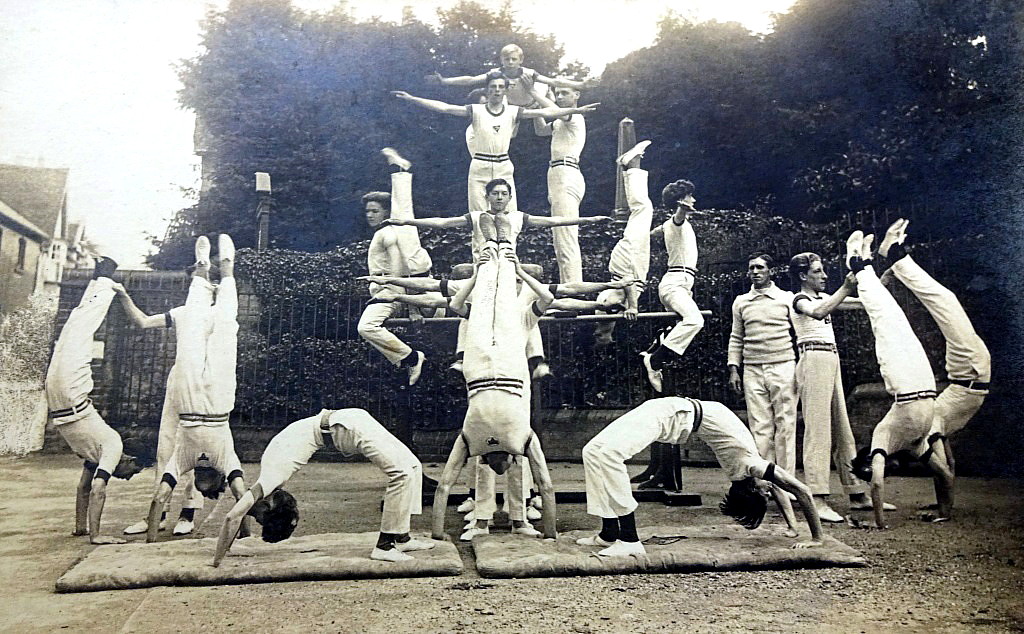
Tring Y.M.C.A. gymnastics
display team (date unknown).
|
Up to about the year 1913 my father had a beautiful grey mare,
‘Dolly Grey’,
who used to pull the four-wheel open furniture van. She was Lew Crockett’s pride and joy.
Her coat was groomed until it
shone, her harness was a picture, and when she went to be shod Lew
would put a blanket and halter on her, put me on her back, and off I
went at 7 in the morning to Mr. Stratford the blacksmith.
Dolly
Grey knew her way.
Mr. Stratford always made tea in a big enamel jug. He threw the tea into
the water, put it on the forge fire, blew the bellows until the
sparks flew and mash the tea. He then poured the milk and sugar into the jug and
out came tea the like of which I haven’t tasted since 1913, mainly, I
think, because the jug was only washed out when it wouldn’t hold any
more tea leaves!
My father bought Dolly Grey from Squire Jenny of Drayton Manor.
She never looked happy when she was in the van delivering or
collecting furniture being driven by Lew Crockett with William Brackley. I am
quite sure she felt it beneath her dignity. We also had a high,
two wheel cart that father drove when out making his calls, viewing auction sales or
attending Aylesbury market every Saturday when we
always ‘shut out’ and stabled at the Chandos Arms livery stables and
public house. As soon as Dolly was harnessed into the cart she
looked completely different. To see her trot was a picture, head in
the air, a proud and beautiful creature. One day when father and
I were going to Berkhamsted down the long hill known locally as Pendley Beeches,
when Dolly stumbled and went down in a heap on the
road. Father and I were both thrown out of the cart. I was of
course crying my eyes out with fright, but father quickly picked me
up and sat me on Dolly’s head which, as any horseman knows, is the
only way to make a fallen horse lay quiet. He then undid the
harness, dragged the cart back so she was clear of the shafts,
pulled me off her head and up stood Dolly Grey, trembling as only
a hurt and
frightened horse can. Her poor knees were cut and bleeding and I can
still see my father tearing up his shirt to bandage those cuts.
We all walked back to Tring. Neither of us ever got over that
incident and
father never drove Dolly again. She had to be taken to
Mr Seaton’s livery stables at Aylesbury where I am sure father sent
her because he wouldn’t have her put down in our own yard. Lew
Crockett had to take her. I saw her go but my father didn’t,
for he loved that grey mare. The cart and van
were sold except for the two solid wooden boards that ran along the
side of the van, which were written in gold letters ‘John Bly,
Antique Dealer, High Street, Tring’. These were taken off and
afterwards used on every van for many years, but eventually our Austin
van was stolen in Watford. The first thing the thieves did was to
rip off the name boards and smash them – we got the van back but not
the boards. I would rather have had the boards, the van I could
have replaced.
During the three years 1913 to 1916, so much happened. The
saddest of these years for father, mother and myself was 1916. I had no
brothers and only one sister, Doris Rose Bly. Doris was nine years
older than I, which meant that for twelve years when I was in any
real trouble Doris was there, guide, comforter, friend and wonderful
sister. Then Doris died from an illness that modern medicine will
cure, but in 1916 pneumonia was so often fatal. Even after
fifty-four years there is still no need for me to look at the old
photography album to remember her. She was such a pretty girl, slim
built, a talented musician on piano and organ. She played the organs at
two local Nonconformist Chapels, both having manually operated
bellows. When she practiced I used to go along to blow the organ
–
often, I regret to say, under pressure. Then within a few
weeks of her twenty-first birthday the end came, and although my
mother lived to be nearly ninety she never really recovered from
losing her Doris.
Doris was engaged to be married to a Tring boy, Archibald Bishop,
who, like most of the boys of that age group was in the Army.
He had been severely wounded in France and brought back to
a hospital near Manchester where Doris had been to visit him a few
months before her death.
Tring was still very much a Rothschild town (of which more
later), but when anyone was seriously ill straw was always laid for
about a hundred yards all over the main road to deaden the traffic
noise, for all the horse-drawn heavy carts and vans had iron tyres and
‘strawing’ was quite a custom to the time. The Great War was
on, so the heavy army gun-carriages and transports made such a noise
that Lady Rothschild had some of the older men who were still left on the
“Home Farm” bring down fresh straw every day throughout Doris’s
illness. Just another thing I shall always remember the Rothschild
family for, and I think that was the last time straw was laid in
the High Street. |
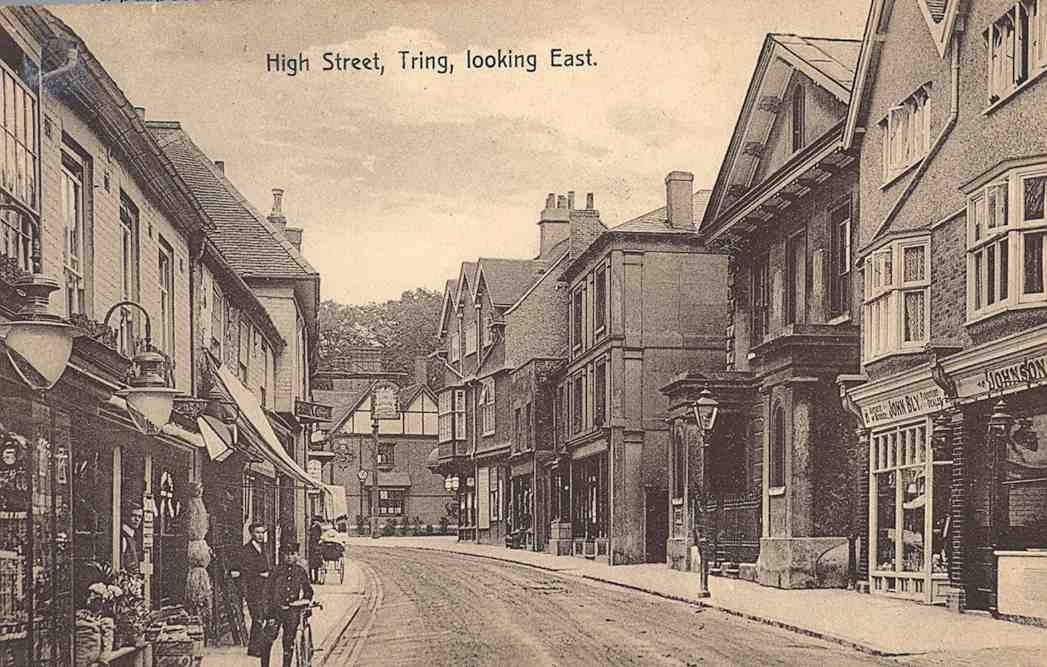
John Bly’s father’s antique shop is on the right of the picture,
next to the Tring Bank (Thomas Butcher & Sons).
The shop was pulled down in 1911 and later became the site of
the Midland Bank.
|
My father’s shop was one of the oldest
buildings in the High Street and we all lived above and behind it.
One
bedroom was built over a gateway leading to the yard at the
back, and also to the garden and coach house of the adjoining
property, which was the surgery and home of our local doctor.
In 1911 my
father’s landlord suddenly decided to pull
down the old shop together with that next door and rebuild. This put father into difficulty, but
fortunately the Old Brewery House with its yard and garden was empty and
only about three doors away, so into it we moved while the
rebuilding took place. This for me was wonderful; a big house, all
the old brewery buildings to explore and an immense garden, room for
rabbits, pigeons and, in fact, all creatures great and small.
1911 was a very hot summer. On the day of the great Agricultural Show in Tring Park,
while we were all at the show a terrible thunderstorm broke and a man was
struck by lightning and killed, which to me was awful and very
frightening. The Show was run under the very active support and
Presidency of Lord Rothschild. It was always held on the first
Thursday after August Bank Holiday and was known as the greatest one
day show in the country.
In 1913 a wonderful thing happened. After losing Dolly Grey father
didn’t buy another horse, but instead he bought a second-hand four-seater
open Humber car, two years old. Wm. Wright, the local coach builder,
took off the body and replaced it with a new open van body nearly like the
old horse van. It was beautifully painted, with all the panels and spokes of the
wooden wheels finely lined and varnished, and on went the old
walnut and gold name of John Bly. To me and old Lew Crockett this new motor was a great
joy. He would never go home at night – regardless of what time my father returned
– until he had washed the
tyres with a wisp of straw just as he always did with the horse’s hoofs, singing in a musical hissing breath as only a good old groom
could. But Lew really worked on that motor. All the brass shone, the big
oil lamps always trimmed and that van, which was one of the first
motor vans in Tring, looked a picture.
That Humber was a fine piece
of engineering. Ignition was a magneto with open chain drive, but as
this made starting – by hand of course – difficult. A coil and
accumulator were fitted, so one started on the accumulator and after
the engine was running switched to the magneto. This switch was
marked ‘M’ and ‘A’ (magneto-accumulator) – my father told me when I
asked what these letters stood for, Mestophalese and
Appolion. The clutch was a cone shape type with pads of thick
leather so when one needed a new clutch lining it was the saddle and
harness maker who had to do it. The leather was usually socked in
neatsfoot oil [Note] to keep it soft and smooth in action, but with a
heavy load of furniture on the van the clutch slipped on every hill, so father had a better idea.
When he came to a steep hill out
came the floor boards in front of the driving seat. A plank of wood
(cut to the exact length and kept for the purposes) was wedged to
keep the clutch pedal down, then, with a long palette knife, Fullers
Earth powder was shaken on the leather. The wedge was then removed
and, with a terrific jerk, we sailed up the hill. The only trouble was at
the top of the hill we had to stop and repeat the process, except
this time the Fullers Earth had to be washed out with paraffin
from a brass syringe. All this was caused simply because my father
had a van body big enough for a half a tone of furniture and two
men on a motor that was only designed to carry four people!
Our
coach house and workshop at that time opened out on to a
semi-private road which only ran about 200 yards from the High
Street to the west door of the church. Whenever the van stood in
this little road, William Brackley, who soon learned to drive,
would start it for me and I used to drive backward and forward.
There
was no room to turn, but going forward the road was long enough to change gear
twice, then reverse all the way back and start again. These were
the only driving lessons I ever had.
All good things have to
come to an end and one sad day in 1915 this van was commandeered by
the military and away it went to war, less the walnut name boards, which really takes me back to 1914 and the outbreak of the Great
War. The first act which impressed me about the coming war was the
day in August of the Agricultural Show and seeing all the
horses of every sort, size and breed, from the fine pedigree Shire
horses to the horse the farmer used to bring his family to the show.
They were all numbered and catalogued ready for war, because the
start of the Great War was really a horse-war as far as transport
was concerned.
The second impression was seeing Army Officers, each with a
policeman, divide the town into sections, visit every house,
count the rooms, count the family, then come out and chalk on the
wall of the house or cottage a sign K/4, then below it one, two,
three or any number. This meant “Kitcheners fourth Army”, with one man
to be billeted in this house, or two, etc., for every house had to
filled.
No camps were ready and to the joy of all we ten year old boys, the
soldiers were coming. Late one night they arrived at Tring
Station, marched the mile and three-quarters into the town and
stood in the pouring rain, in the
light of a lantern, as one went into one house, two into the next
and so on. But they were not what we boys had expected. Only the
Officers and Senior N.C.O.s had uniforms, other ranks were in
their civilian clothes. They were all young volunteers, wet, cold
and
hungry in their rough working clothes grimed from their
previous occupation, for they were miners straight out of the
coalfields of the north east. They even spoke in a dialect we
couldn’t understand for we had never heard a ‘Geordie’ in our part of
the country. They were soon to be members of two proud regiments, The
Northumberland Fusiliers and the Durham Light Infantry. We had two
billeted with us. Both were regular soldiers, Regimental Sergeant Major
Parker and a corporal whose name I cannot remember, but R.S.M.
Parker I shall never forget. He was the first Sgt. Major I had ever
seen, or heard, and when he spoke I jumped, for he really put
the fear of God in to me. After that I never liked Sgt-Majors.
Even years afterward when I was a Private in the Second Word War,
when the first Sgt-Major shouted at me I thought “I’ll bet your
bloody name’s Parker”.
Note.
Neatsfoot oil is a yellow oil rendered and purified from the shin
bones and feet (but not the hooves) of cattle. “Neat” in the
oil’s name comes from an old English word for cattle. The oil
is used as a conditioning, softening and preservative agent for
leather.
――――♦――――
EARLY DAYS OF THE WAR
by Doris Miller (Neé Baldwin)
1940 saw the beginning of petrol rationing, meat and food rationing
of all kinds. Identity cards were issued as were dockets for
furniture. Everyone registered at the Food Office in Miswell Lane,
which was run by Bob Kempster with Mrs Emmie Hobbs assisting him. Later in the war our retired Tring Police Sergeant,
Sergeant Mansfield, joined
them.
Each person was issued with a Ration Book for meat, bacon, sugar,
tea, butter, lard, margarine and cheese, also eggs, unless one kept
poultry. They were issued with poultry feed coupons, which
most people bought from Meads Flour Mill.
Also in the beige-coloured ration books were “points
coupons”. If you were lucky, perhaps two or three times a year, you
could get a tin of fruit or fish if the grocer had had a delivery. When your points ran out it was “hard luck” for another year. Sweets
were also on coupons as were clothes. There was a lot of black
marketing going on with people buying sweet or clothing coupons off
poorer families who couldn’t afford luxuries.
By now all slaughtering was done at abattoirs only, which was Reg
Sallery’s in the High Street (now Almars) and the meat distributed
from there.
Syd Baldwin, the manager of Produce Butchers, New Mill, bade
farewell to each of the three young men who worked for him when
they were called up. So who was going to deliver the meat to the
villages on Friday nights and Saturday mornings? There was Aldbury, Wiggington, Wilstone and Marsworth.
Syd couldn’t drive, so his
daughter Doris had two quick lessons from Percy Dwight before he was
called up. She says she really hadn’t a clue, but managed somehow.
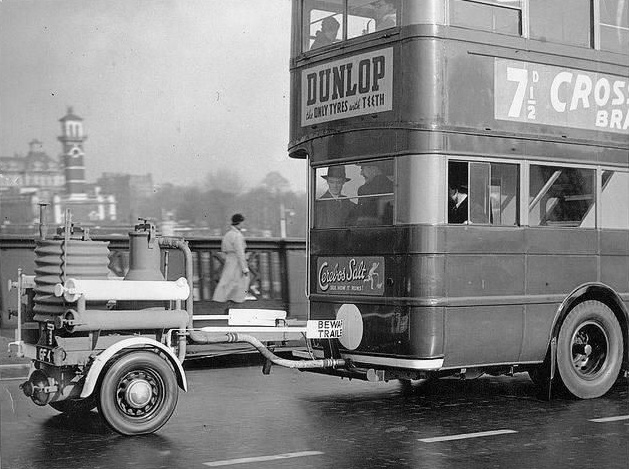
A gas-powered London bus.
The old green double-deck London Transport buses ran on town gas. They
towed quite a large trailer with a black gas cylinder attached. It
was very effective.
No-one had to go out without their Identity Card, which bore their
personal number and, of course, they always had to carry their gas-mask
with them.
Young couples started marrying before their loved ones were posted
overseas. If they were lucky enough to find somewhere to live, they
were issued with a few furniture dockets for the bare essentials
i.e. a bed, chair and table. Pregnant women were issued with a green
or blue ration book and if they were lucky enough got one or two
bananas a month - if the greengrocer had a delivery. After the birth
they then exchanged the book for a green one for the child.
Black-out material wasn’t on ration as everyone had to buy it to
black out their windows, after they had put masking tape,
criss-cross on their window panes, to stop flying glass in the event
of an air raid.
Coal was in short supply, so people used to go to the woods
to collect old timber for their fires. Many also went to the
coal yard at Tring Station and filled sacks with coal-dust, then
mixed it with a little dust or cement to make brickets, which burned slowly
but effectively!
Towards the end of 1940, whale meat was introduced to the local
butchers in an attempt to eke out the meat ration. It was dark red in
appearance, but after being exposed to air for a while it turned black. Sad
to say it didn’t catch on. Housewives tried many ways of cooking it,
with pans of onions, etc., but it was still tough and had a fishy
taste.
――――♦――――
MEMORIES OF A TRING EVACUEE,
by
Joyce Hollingworth (neè Forsythe).
When I first arrived in Tring as a very frightened little girl I
wasn’t very impressed. I was sent to a couple who didn’t want an
evacuee, so I had to sleep on the bathroom floor, although I was
very comfortable and warm. The place was spotless, but being bankers
they were rather posh. Eventually
I was moved to the real Tring. There began the happiest
time of my childhood when I heard someone say “Hello, my duck, would
you like to go to the pictures?” I knew I was home.
In those days
Tring seemed much smaller. I thought it was wonderful
after living in Enfield, which I thought was quite countrified
although
compared to Tring it was a town.
There were so many new experiences for me, things that I would never
have had the chance to do had I not been evacuated. I
tobogganed in the moonlight on Lord Rothschild’s Estate, tramped
through the woods, “ooding” with old Aunt Flop – that meant collecting wood for
her fire. I saw a subsidence where seven trees had gone one on top
of the other. I nearly got caught scrumping greengages. There were
so many things I did that could only happen in dear old Tring. It
was all great fun for a townie like me.
My friends who looked after me were kindness itself and couldn’t
do enough for me – indeed, they did everything for me. Nell used to
make my clothes out of any material she could get hold of, and I
was the smartest “vac” in town. One of my dearest memories is of
Fred, Nell’s husband. I was eating tomatoes on toast when he knocked
on the back door, just back from Dunkirk. There he stood in a
uniform made up of all bits and pieces, but we were so pleased to see him.
I live on my memories of Tring and here I am, 60 years later, still
in touch with the family that looked after me so well, who I love
dearly and visit whenever I can.
Note: The lady who looked after Joyce was Mrs Nellie Nicholls of 17,
Henry Street.
――――♦――――
EMUS, TOBOGGANS, FIREWOOD AND OLD TIN PLATES.
Some memories of Ron Kitchener, pictured below,
enclosed in a letter dated
December 2001.
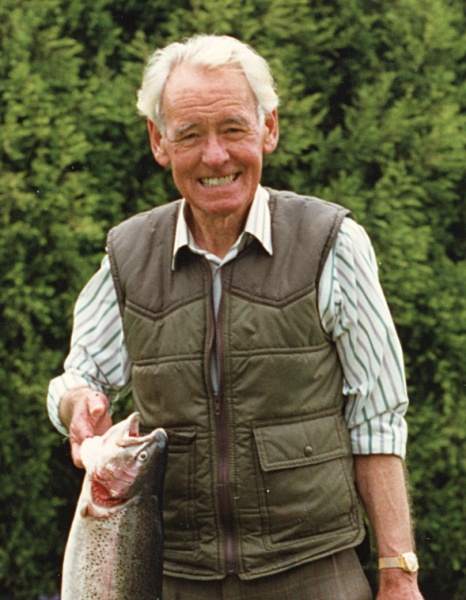
|
Photo courtesy of
Mike Bass. |
It was a renowned travelling historian who wrote that he saw emus
peering over the ha-ha and boundary wall that separated Nell
Gwynne’s Avenue from the Old Market Street, the site of the cattle
and general market place that we tend to think of in these modern
times as the Lower High
Street. I never did, neither have I spoken
to anyone who could enlighten me as to that being a fact (which is
not to say it was not!).
|
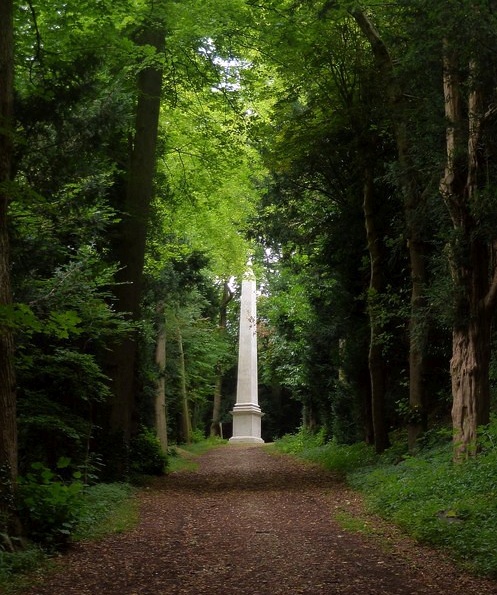 |
|
Nell Gwynn’s
Obelisk, Tring Park. |
My earliest memories of these large, foreign, cursorial flightless
birds was as a young boy in the late 1920s. Many families would
follow the fenced path extending from Park Street (once
Maidenhead Street) up to Tring Park, particularly at weekends.
They would
picnic, play in the park, or to continue through it, usually close
to the set footpaths, and through the park wood up the cobbled track
to Nell Gwynne’s Obelisk
(it was a path of inclined banks, of wild flowers,
snowdrops and daffodils, and always so clean and tidy) to witness
many a herd of deer that ventured from the wood to the isolated
fringes of the open park. Children would run around the Obelisk (surrounded by a fence)
sufficient times to be giddy from the effort, in the belief that a
ghostly image of dear Nell would appear to present them with an orange,
but she
never did!
The final resting place was usually situated on the high
headland of the Oddy Hill, there to admire the idyllic view reaching,
in the east, to the Chiltern Hills and to devour
the goodies from the picnic bag. However, now to back-track to
the point where we entered the park, which was through a very tall
iron clapping gate, where traumatic happenings would often be
experienced! These cursorial and often ‘cursed birds’ were very aware of the
walkers, which they saw as a source of food. This was given
either with generous
consent or taken by some form of scrounging or intimidation by
attacking the source in a persistent way. Some were gentle, most
were not – far from it! Their size and trampling were awesome
enough, but their long necks and small heads (with a penetrating
glare from hypnotic eyes) would strike like a cobra at anything
that appeared edible. It was a frightening experience! Often
they approached in an Armada, and any bright shining article – a
brooch, hair clip, badge watch, pocket handkerchief or the like – that
protruded from a carrier bag or handbag was deemed a tasty morsel.
Earrings were a speciality, never to be chewed but swallowed whole. To those who recall Rod Hull’s Emu and its attack on Michael
Parkinson, it was a close impression of the reality that could exist
in Tring Park, and that’s a fact. My personal experience in those
tender years of childhood was to feed an emu with a spearmint
chew from my pocket - needs I say more? For want of more, it
sought to rape my person and pocket! I ran many hundreds of
yards along the park path with this persistent creature in pursuit
until I reached the monument gate. Phew! I shall never
forget that experience!
So frightened and out of breath, and still to hear those plonking
three-toed feet behind me, no wonder I was always carried a stick
with me whenever I went walking thereafter. I certainly did not want
a like experience, neither did I seek to scrounge an orange from
Nell Gwynne’s basket! But there were several other experience, that
I well recall from visiting Tring Park that i shall never forget. |
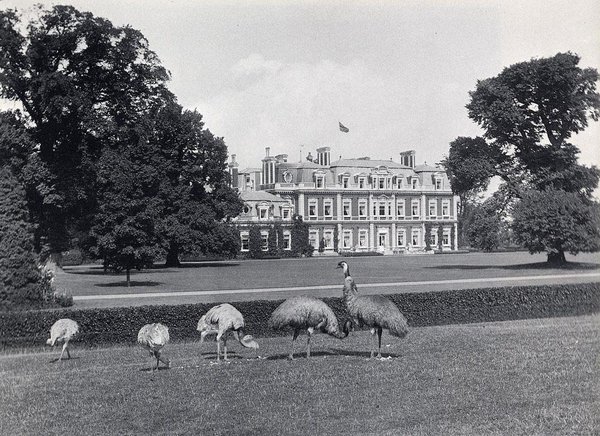
Emus in Tring Park.
|
It is my habit to ramble on through local history,
so I will mention several other of my experiences that happened in that part
of the Rothschild family’s domain.
When winter arrived, and the snow laid right and frost
prevailed to glaze its surface, local folk would make tracks for
Tring Park. It seemed a time when the Rothschilds permitted the
public to venture across the Park with their home-made
sledges and purchased toboggans to the slopes of the high
rising escarpment, where greater challenges existed.
Three main runs come to mind. The ‘emu path’ or footpath that held
close to the fence and the steep incline on the south side. This
appealed to the less venturesome, where the children would skid
down on their sledges,
toboggans and tea trays, without too much harm, for it levelled off to a
gentle stop. ‘The devil’s bump’ lay along the valley to the west.
It was a steady slope with a sudden drop that could take the breath away!
But the greatest challenge and the greatest thrill was the ‘leafy dell’,
which required nerve and courage to face, a real thriller! One
needed to drag one’s conveyance high up the escarpment among
the trees, then, not to gently sit but to leap on whilst it
made off! So many who sought to do so tempted providence. It was necessary to manhandle
the sledge amongst the massive tree trunks that
blocked the way, but that was only part of it!
At the bottom of the slope were masses of long established hills
that gave the final thrill, which was to take off like a plane and fly. Very
few ever completed the challenge and many were often much the worse
for
their experience. I recall my last attempt, with four on the sledge! We didn’t make it,
for we hit a tree causing a school
chum to suffer broken bones and hospitalisation. The other
members of the crew learned from that disaster –
never again!
Yet, much later in life, as fathers do, I sought to demonstrate to
our two sons that I was not past such an adventure, not down the leafy
dell but the devil’s bump, and did I bump! There comes the time to learn
by foolish experience and at best to venture to show off on the
gentle slopes! But such times have passed, and to stand and watch seems
wiser.

Negotiating a bump on an old
tin plate, Tring Park.
But the mind still backtracks to the difficult and hard days of the
past, to when the winters seemed much harsher and longer! When
central heating systems were only for the rich, and (one wondered )
how to keep the homes fires burning when coal supplies and reserves
where depleted and deliveries were very sparse.
Lord Rothschild gave permission for any to enter the Park and
woods to collect fallen boughs to use as firewood, and many
people would face the donkey work to do so. Any form of personal
conveyance was utilised – old trucks, trailers, pram chassis, cycles
and baskets; shoulder carrying and even dragging by rope or
chain. T’was then I joined the trek to strap a long log to the frame
of my treasured bicycle to find the load so great that it broke!
So the memories of Tring Park prevail, some wonderful, some not
so! Just too many to mention.
Now I rarely venture to the extremes of it.
――――♦――――
AKEMAN STREET IN THE THIRTIES AND FORTIES,
by Doug Sinclair 2008. |
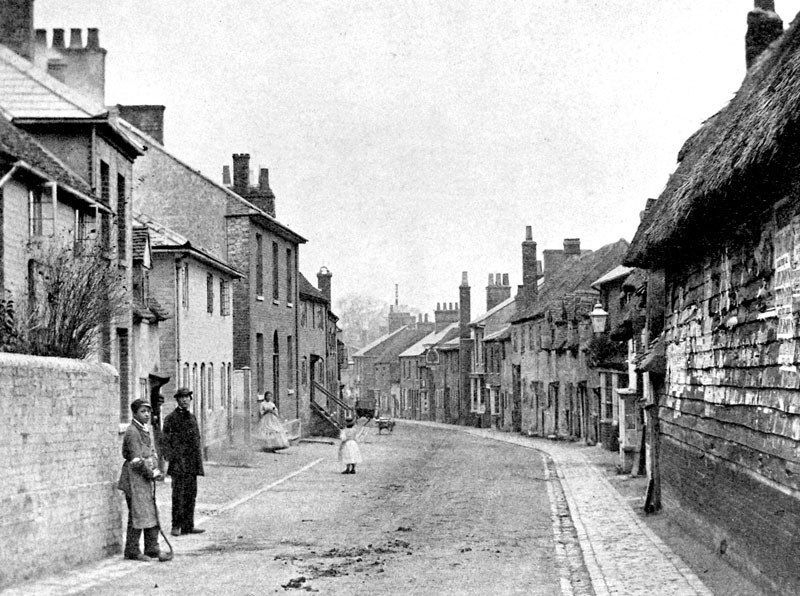
A 19th Century view of Akeman
Street.
The Walter Rothschild Zoological Museum was later built on the site
at the right.
|
I was born in a room over the alley leading to Clements Place in
Akeman Street on the 28 September 1927. Thus started a wonderful and
mainly happy childhood.
At a very early age I was left with my aunt Win while my mother was
hospitalised. In those days relatives or neighbours took on children
in need, with no thought of monetary rewards or meddling by do- gooders. By the time my mother came home I had bonded with my aunt,
and so they decided that she would keep me for another week or two. This stretched to the day I was called up at the age of eighteen.
I have fond memories of my Uncle Jack, a north-countryman who had
come to Tring with the Northumberland Fusiliers in the First World
War. He had been badly gassed in the trenches and suffered very poor
health, but he never complained and worked hard all his life. Complaining people of this generation could learn a lot from those
who really had to struggle.
As I child I lived in Surrey Place. It was a very different place in
those days. It was approached by an arch between Batchelor’s shop
and a row of cottages. Inside was a row of derelict cottages which
had fallen into disrepair. Further into the yard was a row of three
cottages. We lived in the middle one, No 5. There were two bedrooms
with an upstairs attic, and a tiny kitchen and front room downstairs. When I think that during the war
it housed me, my aunt and uncle, and four evacuees – it really puts overcrowding
into perspective!
Surrey Place was almost a community on its own. Everybody tended
to stick together as a group including Mums and Dads. Summer
evenings where an excuse to have a good old gossip and it was quite
a sight to see all the ladies perched on their dustbins doing just
that.
As I approach the age of 81 I feel it is time to record my memories of Akeman Street,
which in the thirties was regarded as
the main hub of the town. I thought of several methods, but decided
to concentrate on the myriad of shops and businesses, ranging from
bakers to breweries, which used to be in the street.
The first shop at the bottom of the street – technically in the
High Street – was Alex Smith the chemist. I remember him as a dour
Scot, very distinguished looking and a highly respected member of the
community. As children we used to wonder what weird and wonderful
potions were stored in the large coloured carboys in the shop window
– little did I think that in later years I would be cleaning it as a
window cleaner.
Next came Parks Electrical. Mr Tom Parks was the proprietor
and I believe his was the first shop in the town to stock TVs. I well
remember taking our radio accumulator to be charged – I think it cost
sixpence – and to be told not to spill the acid, or unspeakable things
would happen to me. On special occasions, such as the Cup Final
or the Derby, Parks would put a tiny TV in his garage for
people to view. What a great day! Phil, his son, went on to be a
stalwart in the towns’ football team.
The came the Victoria Hall, which in the thirties was probably
the most important building in the street. It was the H.Q. of
the British Legion – until stolen from
them by Dacorum Borough Council in the 1980s – and as such housed the brass band.
In those days
it was forty or more strong and a stirring sight to us
youngsters in their smart blue uniforms. The hall was also used for
children’s parties at Christmas and on other the occasions. Dances
were held twice weekly and they gave lots of pleasure, especially
during the war when the Americans from Cheddington Air Base would
turn up. They came in large numbers suitably controlled by the
Provost Marshall and his ‘snowdrops’ (American military police) in their
distinctive Jeep. The British Legion, especially the ladies, put on
many plays and variety entertainments
and the large hall was always sold out. |
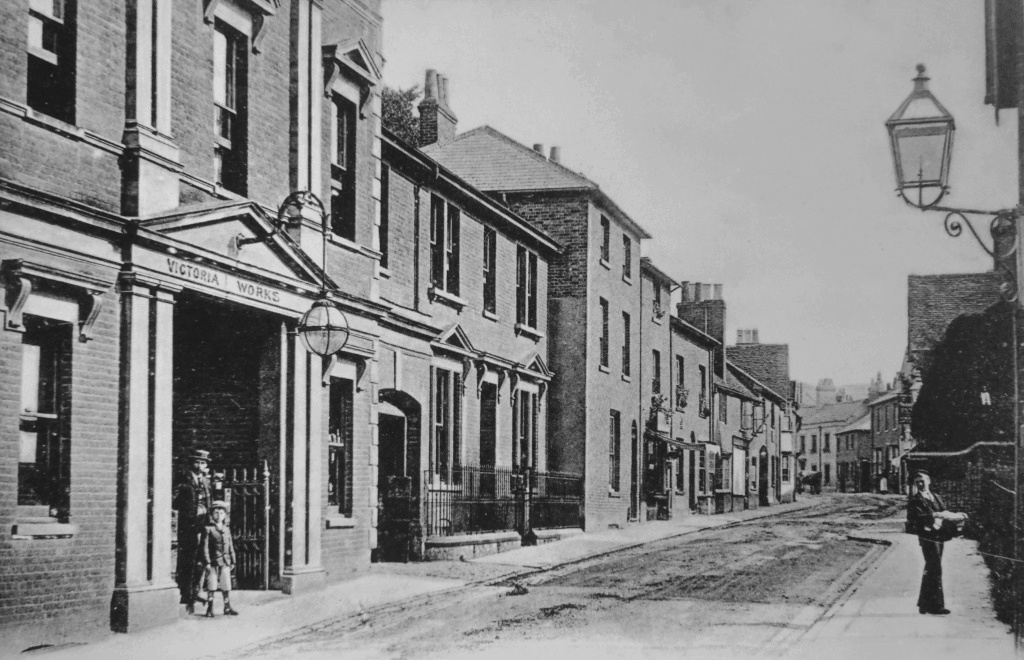
|
The Victoria Hall in Akeman
Street (on the left) was erected in 1886 to a design by local
architect William Huckvale (1848-1936). It set out in life
as a speculative playhouse, failed, and has since had a varied
career, serving out part of its time (the
‘Works’ seen here) as a pickle
factory. It was later presented to the town by Victor, 3rd
Baron Rothschild, and today houses council offices and function
rooms. |
|
After Parks came Sayers Newsagent and Barber. George Sayer, the
owner, was also at one time bandmaster of the Salvation Army Band,
which was very strong at that time – I believe his sons also played
in the band. My first haircut must have been at Sayers, for all the
boys went there. For several years the shop ran a very popular
lending library. I remember being a paper boy at Sayers for
1/6d (7½p) a week. Today’s boys don’t know how we lived.
We next come to George Sykes, a favourite haunt of teenage boys
because a glass of Rodwell’s lemonade could be bought and drunk
in the shop. He was a confectioner and tobacconist.
Ernie Childs, the shoemaker, had the shop that is now the fish and
chip shop. I can still remember the smell of fresh leather and
polish that emanated from the door as we passed by.
“Curly” Burch ran the fish and chip shop for Mr Keele. Then it was
the little bow-fronted shop next door to the present one. We used to
ask for a tuppeny piece of fish and one penny-worth of chips, and
please can we have some crinklings (small pieces of batter)? Curly
was a real character and well liked by everybody. Eventually he and
his wife took over the shop and ran it for many years.
Next door came my Uncle Harold who, for a while, ran a second-hand shop.
I don’t think it was much of a success because if Aunt Norah (who was a
wonderful Irish lady) thought that people couldn’t afford things, she
was quite likely to give it to them.
We are not yet halfway up the street.
We now come
to Grace’s Maltings. In the thirties this was a very busy mill and
my most vivid recollections are of a flock of bantams that roamed
around the mill yard. Many a time I have had bantam cocks attack my bare
legs as I walked past on my way to school. It used
to be a favourite errand to go to the mill for three penny-worth of
mixed corn to feed the chickens that most people kept – nearly always a springer
spaniel belonging to Bob Grace would be sleeping in the sun. I remember how
scary the inside of the mill was, with everything shaking and vibrating.
As we move further up the street, the next shop belonged to George Woodward. It
was a tiny cottage type shop selling mainly sweets and tobacco. I
always used to buy penny bags of broken crisps and I can recall that
that was where I purchased my first ever Wagonwheel. It seems to
have been twice as big as they are now, but I suppose childhood
memories always magnify. The Woodwards had a lodger who used to
travel for Betterware. He used to be immaculately dressed in
breeches, black boots and a bowler hat, and he drove a pony and
trap. I believe he as later killed while serving in the RAF.
There was then a gap leading to Pleasant Row, comprising three or
four cottages, which led to Bank Alley. Standing back was Jones’s
Motor Garage, later owned by Stan Cook, a great character. Woe betide the lady with a squeaky wheel on a pram or pushchair. She
would be ordered to stop, and Stan or his Dad would rush out with an
oil can and remedy the defect before the lady was allowed to go on her
way.
Just the other side of the gap stood the general stores of Clara
Bull. She sold a little bit of everything. I sometimes had to go
shopping there and it was a pleasure as she always used to give us
kids a few sweets at the weekend, but not on Sunday.
Mrs Bull used to cook the most delicious fish and chips and for 6d
(2½p) you would get enough to feed a family. The only downside was
that people would buy them on their way to the Gaiety Cinema and
take them in to eat. The aroma used to mingle with the spray they
used in the interval and made quite an interesting smell.
We now come to Bonds the bakers. As children this was our favourite
shop on our way to school. Mrs Bond used to make the most fabulous
cake she called Dinky, but I think most people address it as
Nelson. It was a penny a slice and we always hoped that her
daughter-in-law, Amy, would serve us as she was very generous
with the portions – Mrs Bond was inclined to be less generous.
By the side of the Bonds was the entrance to Rodwell’s mineral water
works, makers of the famous ‘Roddy orange’. I suppose in the
thirties Rodwells had four or five lorries and employed twenty or thirty
staff. My first job was with them, and I remember being paid 11s-8d
(53½p) for a 48-hour week. I didn’t stay very long, leaving to work
for Tring Co-op (that’s another story). It seems such a shame that Rodwells have now ceased trading. |
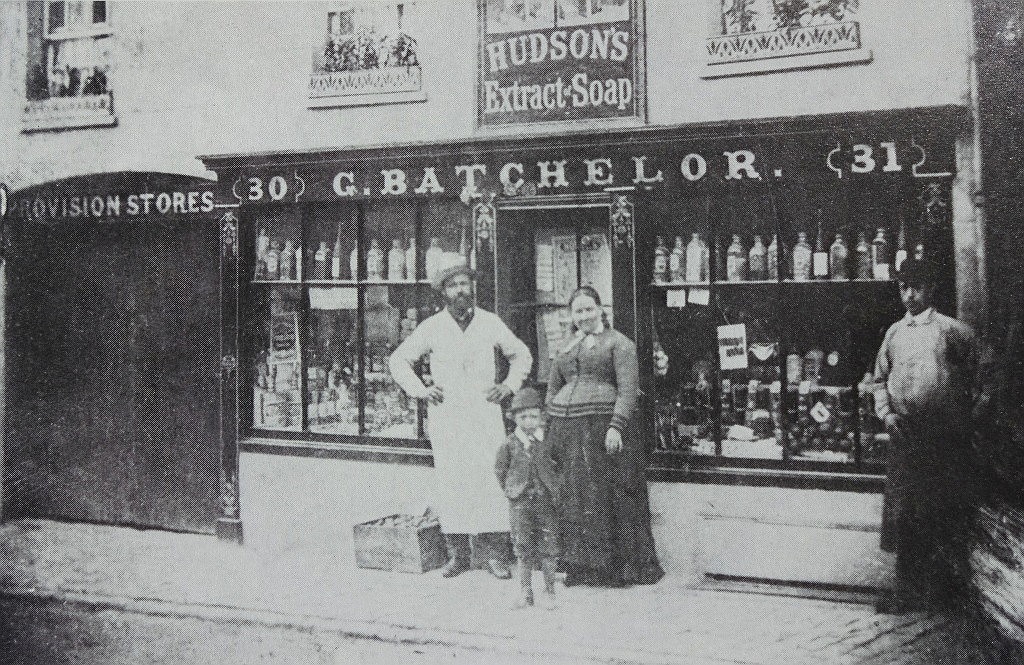
|
Finally we now come to the biggest shop, that of George (another
one) Batchelor. His was the main shop in Akeman Street and he sold
everything, from paraffin oil to bacon. Most people in the street
dealt with George and he ran a weekly book for most of them. Everything was weighed up
– from bulk sugar to dried fruit, such as a raisins, currants etc. –
and packaged in
distinctive blue bags tied with string. I wonder what health
and safety would say about the tabby cat I remember always being asleep in the
shop window. George would, with impunity, serve someone with bacon and the
next person with paraffin, but nobody died. Inside the shop’s
front door was the cellar where all sorts of things were
stored, very much like the Ronnie Barker comedy Open All Hours. |
――――♦――――
|
THREE GENERATIONS OF FARMERS
IN TRING
by Stephanie Wells, March 2019.
I feel very privileged to be born, and still live at Cow Lane Farm,
where my family have farmed for over 90 years. This is mainly
due to the foresight of my grandfather Walter James Wilkins Snr who
applied for 10 acres of land being offered to returning servicemen
after the 1st World War. The Council had purchased land from
large landowners (Rothschild here) and were offering plots to rent
to help servicemen start making a living again.
Grandfather did not do service but was in a reserved occupation
namely taking hay and straw to London by horse and wagon and
bringing back soot to use on the fields as fertiliser. This
was taken from the cellars, bagged up and put on a train at Euston
to be collected at Tring Station for storage in the roundhouse at
Pitstone Windmill. My father Walter James Wilkins Jnr also
went on these journeys as young as 5 years old and remembers staying
overnight in pubs, sleeping on benches or on the floor tied up in a
sack to keep the rats off. Approaching London, a steep hill
had to be negotiated and a spare horse was available for 6d to hitch
to the wagon to help pull the loaded cart to the top.
He was also a horse dealer, mainly for the coal trade and we have
kept a logger which came from a stable in London (I have more).
They were used in the tethering ropes in the stables to keep the
ropes taut so avoiding the horse’s leg getting tangled up.
Soldiers were sometimes on the lookout for horses to commandeer for
the army. They would stop you and remove the horse and replace
with an old nag to get you home. If word was about that the
any were in the vicinity, an alternative route was found home.
Among the WJW Snr’s other occupations were Baker, Ground Worker and
Bargee. Father remembers him walking to Watford and other
large towns to dig trenches and coming home only at weekends.
He had a spell on the horse-drawn barges on the
canal. In fact any job to put
meat on the table to provide for his wife and 6 children (1 boy & 5
girls). He also kept a donkey which he rode to Tring Station
to help unload goods at Tring Wharf on the canal. The donkey
threw him one day and arrived at Tring Station without him.
He was educated at New Mill School where the first signs of his
future character began to emerge, judging by one story he enjoyed
relating. As punishment for a misdemeanour he was told to
stand in the corner with his hands held over his head. The
long-suffering teacher piled writing slates on his hands and when
asked if he had enough, he replied “No Sir, pile them up - I can
take more”. When the pile was a high stack, he dropped his
hands and the whole lot shattered.
MARRIAGE AND A HOME
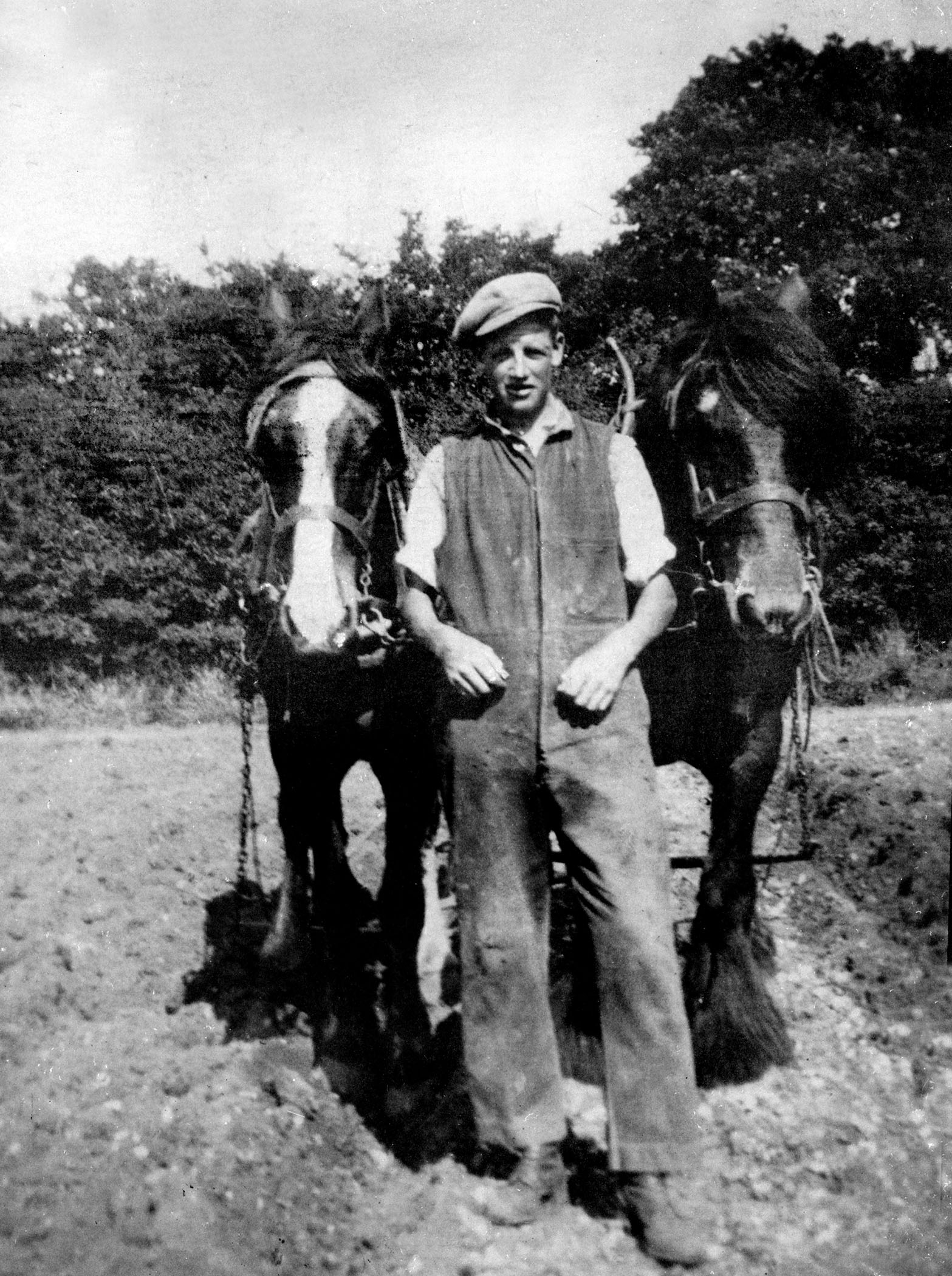
The second generation: W J Wilkins with
Beecham and Blossom, Cow Lane, c. 1930.
Photo courtesy Mike Bass.
After meeting my grandmother from Bulbourne whose surname was also
Wilkins (incidentally my mothers’ parents also had that surname),
they moved into 7 Bulbourne Road, New Mill and lived there until his
death in 1972 aged 92. The house had a yard and outbuildings
where his various animals were kept including a cow. I
remember a well in the garden where the 10 gallon churns were let
down on a rope to keep the milk cool during hot weather.
During the war my father erected an Anderson shelter and I can
remember going down some very slippery chalky steps to this smelly
and damp and dark room where my grandmother stored her bottled
fruits and other preserves. Another important building was the
dairy where the milk was processed before being delivered on the
milk float.
DAIRY FARMING AND DELIVERING THE MILK
After acquiring the 10 acres at Cow Lane as the first Hertfordshire
County Council tenant (info given to me by John Hunt, H.C.C. Land
Agent - I have also seen documents listing applicants and minutes
from meetings discussing them), he acquired further plots as tenants
dropped out and eventually had 25 acres, but no buildings. He
shared a cowshed at Dunsley Farm until the complex of buildings was
erected about 1933. This consisted of a cowshed with standings
for 8 cows and a mixing house with 2 coal-fired boilers to heat water
and boil up swill. This area was later used to enlarge the
milking parlour to hold 12 cows. A stable, box and dairy
together with various homemade sheds made up the smallholding.
The Dutch Barn was erected, probably in the 1950s. In 1938,
the year my parents married, a house was built. Grandfather
wanted to remain at New Mill so the newlyweds moved in and my sister
and I was born there during the war. Another 25 acres were
added in about 1960, making 50 acres.
My father worked on the farm all his life and never thought about
doing anything else. In 1939 he was included in the tenancy
agreement. He helped deliver milk at 9 years old as well as
working on the farm.
The Milk Floats were probably built by Easts at Berkhamsted and
maintained and painted by Bushell Bros at New Mill [Ed. -
proprietors of the Tring Dockyard, a boat building and repair
business].
I was occasionally allowed to harness the horse to the milk float -
checked afterwards by father of course. I also loved putting
the cardboard tops onto the bottles. They came in long tubes.
A popular pastime was making woolly balls from these milk tops as
they were perfectly round with a hole in the middle. Milk was
also dispensed from a large brass churn on the milk float, engraved
with our name. Customers left various containers on the
doorstep and measures were used to give the exact amount required.
The horses knew the route and whilst Punch (as grandfather was
known) chatted to the ladies at the door, the horse moved on to the
next house. Milk was delivered 7 days a week, 52 weeks of the
year, even Christmas, and in all weathers. All the horses were
of good quality and I recall sitting in the High Street School in
the afternoon and hearing the fast clip-clop of horse’s hooves as
the horse knew it was on its way home. The horses worked one
week on, one week off, and during their rest week I had the
opportunity of riding them around the farm. We also had
ploughing horses and I spent many a happy day sitting on their backs
up and down the field. A good day’s work was one acre per day.
As a matter of interest one of our bouting ploughs [Ed. - a
double-furrow plough] is on show at Dunsley Farm together with a
mower for cutting hay. I also let them have a weighing machine
for sacks as they are better seen there than at Cow Lane.
In the mid-1950s the milk round was sold to West Leith Farm.
This was due to pasteurisation regulations coming in. Grandfather
wanted his customers to have his own milk - not anybody’s. We
continued to milk and it was collected by lorries until bulk tanks
were required. At this point a decision was made to give up
milking and stick to suckling cows and rearing calves.
The Milk Float was sold to Hunters Farm at New Ground for £2.
10s.0d. and used as a donkey cart for the children (note: shafts cut
off). Dacorum Heritage Trust acquired the cart at a cost, I
believe, of £400 in the late 1980s.
‘PUNCH’ WILKINS
Grandfather was very well known in the town and became known as
Punch. He was often called out by the police if there was any
trouble in the pubs. He only had to walk in and everything
went quiet. He often administered ‘justice’ in Bank Alley
while the police turned their backs. He was also known to tar
and feather anyone who upset him and gave this treatment to his
son-in-law outside the Bothy after he had abandoned his wife and
children. During his life on the canal, his fighting prowess
was put to the test when a coloured man known as the ‘King of the
Canal’ always insisted he put his boat through the lock first.
Punch objected and a bare knuckle fight, lasting for hours, ensued
on the towpath at Northchurch. Grandfather won, leaving a
sleeve from his shirt, made by grandmother, on the hedge where it
remained, marking the site for years to come.
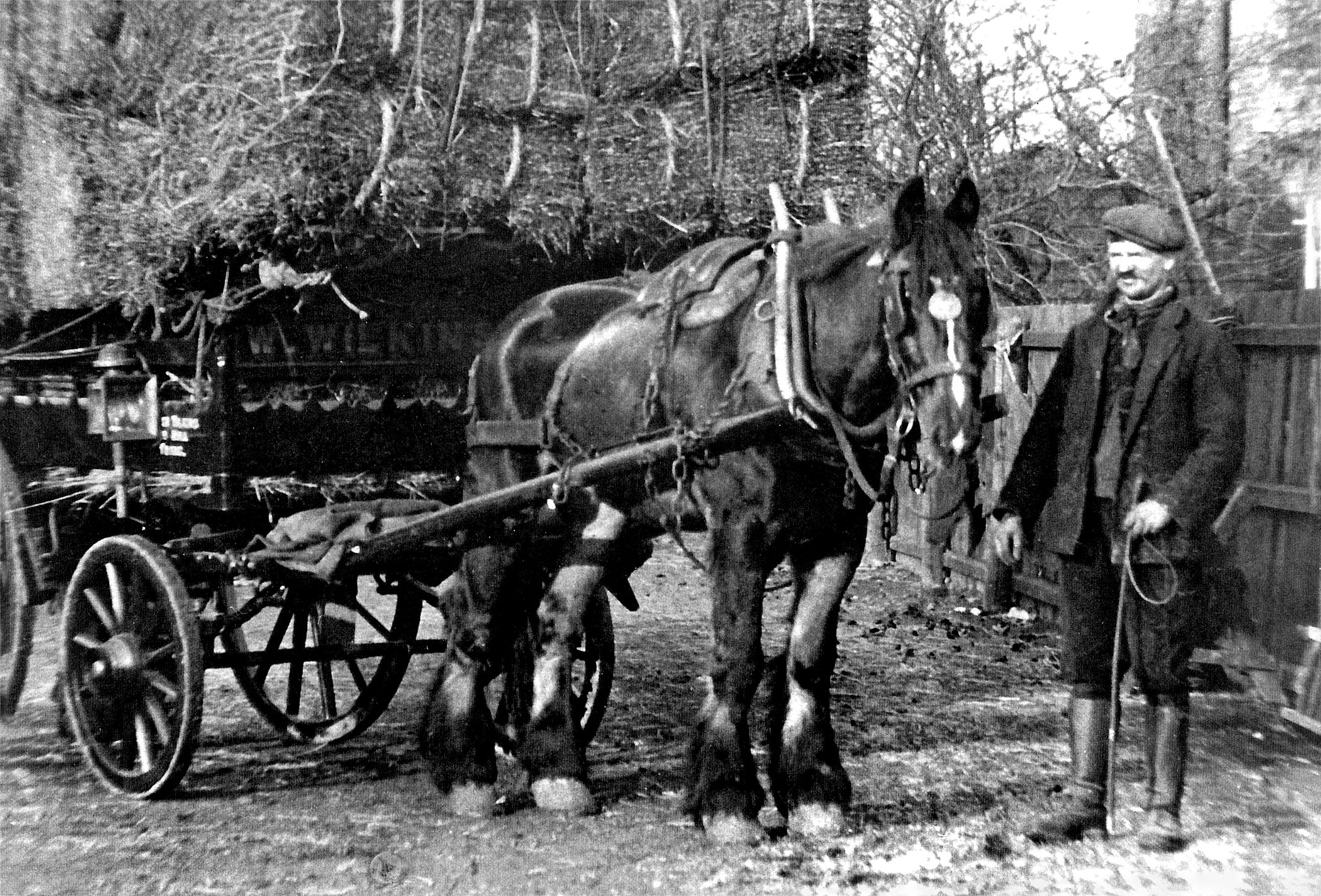
Wally 'Punch' Wilkins.
Photo courtesy Mike Bass.
My father continued as tenant until his death in 2006 at the age of
91. He was the longest-serving H.C.C. tenant. The
Council asked me if I would like to continue the tenancy, farming
the smallholding in a traditional way, as before.
WARTIME
I have wonderful memories of my childhood. During the war, we
had Jewish evacuees named Hille who designed and made high-class
furniture in London. They more or less took over the house but
were very good to our family. They had a daughter a little
older than me and I have faint memories of being pushed into Tring
in a big pram by her Nanny - one curly haired dark child and a curly
haired ginger child the other end.
German prisoners of war came in a lorry to work on the farm all day
unaccompanied and collected at night to go back to their billet at
Northchurch. They had an accordion and sat on the straw bales
singing, having their lunch break. They also made me toys from
wood, decorated by burning patterns in the wood. A pecking
chicken item comes to mind. Dad did fire watching duties with
Miss Galpin a neighbour.
CHILDHOOD
I followed my father and grandfather attending New Mill School.
The bad weather of 1947/8 prompted my parents to send me to Tring
School instead as there was a bus into the town from the bottom of
the lane. During that winter, the school was open every day
and the children dried their wet clothes on the railings around
large stoves, one in each classroom. These stoves often smoked
and the children had to cram into the other classrooms for lessons
and dinner. Meals were not provided at first and I went to
lunch at 7 Bulbourne Road until a small kitchen was built on the
side of the school. We still had to eat our lunch at our
desks. The two teachers were Miss Needham and Mrs Pearson who
were sisters and lived together in the School House at the end of
the classrooms. They had a little black car. Various
modes of transport took me to school and back. I could be on
the milk float, on dad’s crossbar or the crate on my cousin’s grocery
delivery bike, but mainly it was shank’s pony.
When not at school, most of the time I was with my father. He
was a good thatcher and I enjoyed helping him prepare the straw.
Farming was labour intensive and many hours were spent hoeing the
swedes and mangolds and turnips used to feed the cattle in the
winter. They were stored in long clamps made of earth and
straw and when needed, were dug out and sliced in a large machine
ready to mix with toppings, a by-product of flour making at
Meads Flour Mills at New Mill.
Swill was also mixed in. This was collected from Pendley Manor
where soldiers were billeted during the war. We also delivered
milk there. Dorian Williams let us have some land to put our
cows on (where the football and rugby clubs are now).
Hot days harvesting were often followed by a thunder storm at night.
These seemed to go on forever. We never seem to get these
nowadays. There was always a race to get the sheaves into
shocks before it rained. The harvest was brought in by horse
and cart, and hay and straw ricks built and thatched followed later
in the year by a threshing machine. My family took part in
these activities. Mum wore dungarees with string tied around
the legs to stop mice running up.
We never had holidays except maybe a few days with my Aunt in
Worcestershire, but father rarely came. We looked forward to
Christmas though when a pig was killed and all the meat was used.
Faggots and chitterlings were popular and Mum made lovely brawn.
Trips to Aylesbury Cattle Market on Saturdays were our only days
out. We stopped mostly in Tring which had all you needed.
Tring Market was on Mondays.
We owned the Pound Meadow for some years until the Town Council
compulsorily purchased it for playing fields. They paid
grandfather £2,000 for it but he would rather have had the meadows
for grazing. My sister and I had to stand guard at the gates
of the big houses in Station Road when the cattle were being moved
to Pound Meadow. Some people may remember Flanagan’s Fair.
Grandfather used to like sitting in the control box of the Dodgems
chatting to Mr Flanagan. I can also recall circuses with
animal acts being popular.
A visit to the blacksmiths was always exciting - leading the heavy
horses along the Station Road trying to avoid their feet was a
challenge. The horses were tied up and under cover, but
outside to await the Blacksmith’s attention. The acrid smell
of the smoke arising from the hooves was memorable. The inside
of the Smithy was like Dante’s Inferno when the two ovens/forges
were made hot with bellows. Quite often I would call in to
watch the Blacksmith on the way home from school.
FARMING TODAY
I have continued to raise calves which stay with their mothers in
the fields for 10-12 months. They are then sold to a farmer in
Halton who collects them in his own transport thus avoiding the
stress of markets and long journeys. They are raised
traditionally with no fertiliser or weed killer being used, only
manure. Consequently the farm is species rich both in plants,
hedges and birdlife, and has caught the attention of the Wildlife
Trusts who have conducted a survey hopefully leading to Higher Level
Stewardship. I have also hens and geese, and grow vegetables,
some of which are sold in Dunsley Farm Shop.
――――♦――――
MEDICINE IN TRING - A SHORT HISTORY
by Dr. D. F. E. Thallon, August 2000.
When I was first asked to compile a history of medical care
in Tring, I thought there would be an abundance of material which
merely had to be unearthed. Sadly this proved not to be the
case. I recalled that there had been a cupboard full of dusty
documents at our old surgery at 23 High street, and I thought they
might provide a wealth of information. Unfortunately they had
been lost, probably during our move to Rothschild House in 1988.
Therefore I had to rely on the reminiscences of partners and
colleagues of mine over the years as well as the memories of local
historians. Some of their revelations, I have to say, have
been both fascinating and fruitful.
I could find very little material earlier than about the middle
1920s. There were some anecdotes however. For instance,
for many years there was a speaking tube that ran from the doctors
house at 23 High Street to the groom’s room on the other side of the
road. This was used at night when the doctor had to make a
night call and the groom was required to get the horse and trap
ready.
Therefore the story will have to start in about 1925, when the
senior incumbent at the practice at 23 High Street was a Dr Brown.
With the passage of time he has become a somewhat shadowy figure,
but he and a Dr Carpenter practiced together for some years,
followed by Dr O’Keefe, who was still living in Tring when I arrived
in 1962. He and Dr Norman Knox, together with Dr Christopher
Cole, whose family lived in Tring for several generations, were in
partnership until the beginning of the NHS in 1948.
Dr O’Keefe was, I understand, someone who inspired great confidence
and had a wonderful bedside manner. He treated the more
well-off section of the community, while his partner, Dr Carpenter,
dealt with the rest. Lord Rothschild, who was one of Dr
O’Keefe’s patients, required him to visit every day. He was
one of the first people in Tring to own a motor car, having
previously used a motorbike to do his visits.
Dr Carpenter did his consultations from a high desk in the waiting
room, so it seems that confidentiality took a back seat! A
Miss Glanville, reputedly a formidable woman, ran the dispensary and
also sent out the bills. Fees were quite arbitrary and
depended on what it was thought the patient could afford. The
less well-off joined a ‘club’ and paid a fixed amount a year, as
well as a shilling for the (almost) obligatory bottle of medicine
which was prescribed after most consultations. The expression
‘on the club’ is still used by patients today and I have always
assumed that it dates from those pre-NHS days. At that time
practices depended largely on private patients for their survival,
and the doctor's wives had the vital job of calling on all the more
affluent new arrivals in the area in the hope that they would join
their practice.
Medicines for patients living in outlying areas were lefl in an open
cupboard outside the surgery for collection at a time that suited
them. Such prescriptions included items such as sedatives, a
practise which just would not be possible today. The system
was still in use, however, until about fifteen years ago. It
worked well and was never abused. I doubt if this would still
be the case.
There were, of course, other medical practices in the town during
this time, notably Dr Middleton-Brown. He practiced from a
surgery close to the United Reform church in the High Street.
He was considered very high class and had a French wife as well as
three daughters, who were heavily chaperoned. He was succeeded
by Dr John Martin, followed by Doctors Beasley, Steven, Newton and,
at the present , Hall-Jones and his wife Dr Susan Osbond, as well as
Dr Side and his partner Dr Hazel Butland. Dr Vicky Plumb also
practiced single-handed in Queen Street until she retired some years
ago. Mention should also be made of Dr Neil Saunders who used
to help the practices out a great deal for many years until his
death in 1996. Neil’s first love was music. He was a
composer of considerable ability and lectured on the History of
Music at London University. I was never quite sure how he
found time to get a medical qualification!
If a patient needed hospital care, they were usually admitted either
to the West Herts Hospital at Hemel Hempstead, or to the Royal Bucks
Hospital at Aylesbury (Stoke Mandeville Hospital did not exist
before the Second World War). Patients needing long term care
who could not be dealt with at home were usually admitted to St
Paul’s Hospital in Hemel Hempstead. This was originally a
workhouse and has been closed now for some years. Locally it
had an unenviable reputation which, probably unjustifiably, lingered
on. Its poor reputation was probably acquired many many years
ago, but memories can be long and I can still remember the
apprehension of patients who had to be admitted there.
Until the end of the World War II there were also two fever
hospitals, one at Little Tring and the other on the outskirts of
Aldbury. Patients with diphtheria and scarlet fever were
invariably sent there, though other infections were treated at home,
after which the house was fumigated. There was also a nursing
home in Station Road where, if necessary, surgical procedures could
be performed under a general anaesthetic. It was quite usual
for the surgeon to come from London on these occasions. As a
historical footnote it is worth noting that there are the remains of
a Pest House in the woods outside Wigginton where, presumably,
patients needing isolation were sent. This may well date from
mediaeval times.
As with so many other aspect: of life in the town, the Rothschilds
were influential in the development of medical services. Lady
Rothschild, a very considerable person in her own right, paid for
the nursing home in Station Road, which was built around 1887, as
well as the fever hospital in Little Tring built in approximately
1900. They were also generous in other ways; for instance they
provided a nurse to see to all their employees and their dependants
(a high proportion of the local population), and, many years ago,
when there was a very ill patient living in the High Street, they
arranged for straw to be put down to cut down the noise from the
passing traffic.
I am greatly indebted to my ex-senior partner Dr Christopher Cole,
whose knowledge of these parts is encyclopaedic, for his help in
compiling this short history. My thanks are also due to
Michael Adams, also a retired partner of mine, Nora Grace, Wendy
Austin and Ron Kitchener, who all had pertinent comments to make.
An extract from Dr. Fallon’s obituary.
David Thallon studied medicine at St.
Thomas’s Hospital. There he met his wife Jenny, then a student
nurse, and they married a day after his final exams. For the
next 2 years they both worked in hospitals attached to St Thomas’s
and in Burton-on-Trent. David and Jenny came to Tring in 1962
where David joined a General Medical Practice, working there for the
next 30 years. During his career in Tring he was for many
years school doctor at the Arts Educational school and also looked
after the nuns at St. Frances de Sales. David died on the 27th
January 2019.
――――♦――――
SEVENTY YEARS AGO
by Dennis Aldridge, October 1999.
The enquiring newcomer to Tring soon becomes aware of the
improvements introduced by the Rothschilds. Local historians
or biographies of the family draw attention to slum clearance, the
provision of a hospital, and the gift of land for additional
housing. Local mock Tudor buildings prove to be the work of
Huckvale, the architect employed by the Rothschilds.
Substantial houses of a distinctive red brick are recognised as
dwellings of the more important estate employees. Elderly
neighbours of the newcomer will relate rosy recollections of
childhood days helping with harvests well within the present town
boundary; of cycle rides on a virtually traffic free A41; of fun and
games at crowded Agricultural Shows in Tring Park. Present day
glimpses of the surrounding woodland and the hills rolling along to
Ivinghoe complete the new arrival’s impression of an early twentieth
century idyll. The Bucks Herald of March 22nd 1929
presents a somewhat different picture. Tring Urban District
Council had “promoted” a public meeting in the Market House
the previous Friday evening to discuss a proposition to build houses
to be let at a very low rental. The meeting was chaired by the
Chairman of the Council, Mr John Bly. Among those present were
the Vicar, the Rev. T. V. Garnier, Councillors Miss Boyson, F. B.
Fells, G. Goddard, E. Houchen, H. J. Baldock, C. R. Tyrrell, and A.
T. Ives along with Messrs. A. Butcher, A. W. Vaisey, M. C. Kemp, M.
A. Young, E. Wright, F. J. Bly, A. Brooke Turner (clerk to the
Council), H. N. Hedges (surveyor), and Nurse Shore.
Dr Sparrow, the main speaker is quoted as saying: “I could take
you to 20 houses in Tring in which you would not like to live.
Some would not be fit to bring up pigs in. Landlords round here
give their pigs more air and light. I believe there are
something like 100 houses that ought not to be lived in. At
any rate, 25 are not fit to live in, in Church Lane, Albion Place,
Stratton Place and Providence Place.”
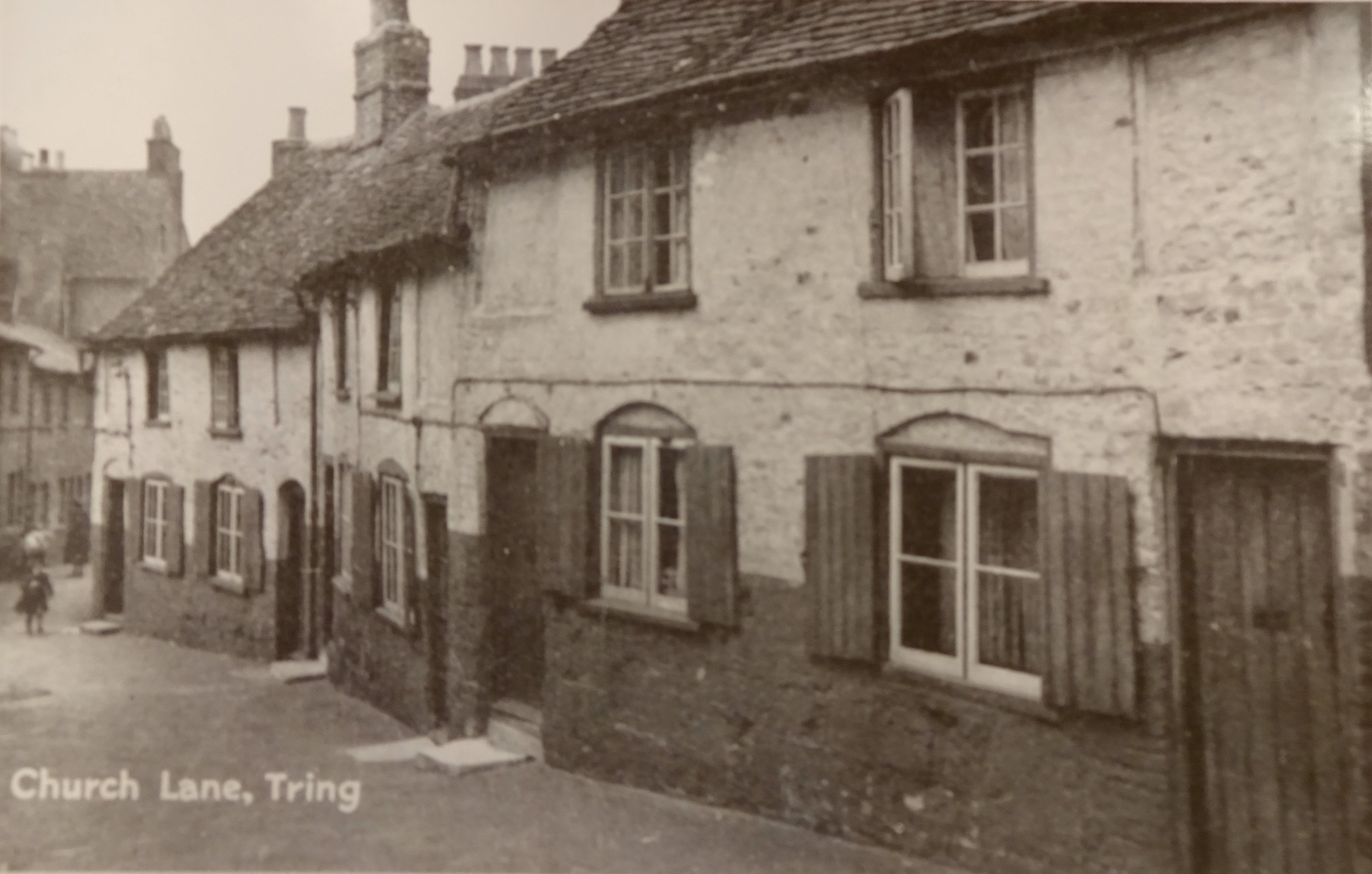
Dr Sparrow was the assistant TB officer for the district and the
medical officer in charge of the infant welfare centre in Akeman
Street. He had been dissatisfied with the housing conditions
for many years although he admitted taking little action for six or
twelve months when fewer cases of illness came to his attention.
But many of the children living in these conditions suffered from
debility, rickets, unhealthy tonsils and anaemic debility. He
urged people who did not realise the need for rehousing to go and
look for themselves. “They could ask themselves how they
would like to live in those houses, without any backs at all, where
the sun never got, where they got nothing but a scullery window,
looking on to a high bank.”
Dr Sparrow had seen in Watford, in Northchurch and in Tring and on
Bunstrux-hill a tremendous change in a number of children through an
improvement in their housing conditions. There had been a case
of seven children and their two parents, all tubercular. “They
all went away to institutions except the mother, who was never able
to go. They got into a Council house four or five years ago
and now all of them were cured except the father. It was too
late for the mother. She would never be cured. Even one
of the children, who was on her back for seven years, was now at
work.”
The provision of more houses for the poor was an urgent matter in
which everyone in Tring should be interested. Dr Sparrow
therefore urged Tring to make a big community effort and to aim at
building 100 houses to re-house those living in the worst
conditions. The audience heartily applauded him and Mr Vaisey,
Clerk to the Urban District Council for over 50 years, agreed that a
very serious state of affairs existed in Tring. Consequently
the Council had decided, said Mr Vaisey, to start an association
which could hold the property (the houses they proposed to build),
and to borrow money on debentures for the purpose of starting the
work. The Council wanted loans and gifts to raise £4,000 to
build 8 houses for renting at 5/- a week. Lady Rothschild had
offered to take up £1,000 in debentures; Mrs Rothschild’s family and
Mrs Williams had each offered a further £500. In fact £2,400
had already been pledged before the meeting. Those present
unanimously supported Mr Vaisey‘s proposal to proceed and a further
£401 were given or pledged.
The Vicar hoped that once people had moved into the new houses, the
old over-crowded ones would not be re-occupied. Only if they
had been reconditioned and only let to small families was the reply
of the Chairman, Cllr. John Bly. -- Church Lane and Stratton Place
did not disappear completely until Budgens, the car park and Dolphin
Square were built in the early 1970s.
――――♦――――
THE TRING ASSOCIATION FOR THE PROSECUTION OF FELONS
March 1996.
The Tring Association was started in 1824 for the purpose of
protecting the property of members and bringing to justice all
felons offending against them. Fees were based on the size of
the member’s property. In 1888 Lord Rothschild paid 10 guineas,
but the average fee for shops or public houses was 7/6d. If
premises were damaged or something stolen, the Association would
circulate reward posters, and also pay the prosecution solicitors
fees.
Records show that in 1845 a Mr George Webb was successfully
convicted by solicitors, G & H Faithful, and the man transported for
life. On 26th May 1845 Inspector English of the Herts Rural
Police claimed £1.13.6d for expenses involved in the case.
By 1881 the punishment was less harsh and solicitors A. V. Vaisey
noted that the defendant, who was convicted for stealing apples, was
fined 15/— or seven days hard labour in default. By 1926, in the
minutes of the AGM, it was proposed that the Association should be
wound up and the assets divided amongst local charities, because
membership had been falling since the War and it was considered that
the objects for which the Association was formed were now obsolete.
This was duly done in the following year.
We have no record of Mr Webb’s crime. Does anybody else?
――――♦――――
THE CLUBS OF A HUNDRED YEARS AGO
by Jill Fowler, April 1997
In the last decade of the 19th century there were, as there are now,
numerous clubs and societies to join. There were sports clubs,
the Oddfellows, the Agricultural Society, the Primrose League and
many others. In June 1891 it was reported that the Tring
Mechanics Institute had found a new home in the house opposite the
Post Office, just built by Mr Gilbert Grace with a reading room
described as "very inviting and comfortable." The Tring
Branch of the Herts Technical Instruction Association received a
record total of £97-4s-7d from the County Council for tools and
appliances and the payment of instructions (Bucks Herald May
6th 1893). Many clubs were reported as having a meeting or
supper in the Rose and Crown, as did the Tring Station Quoits Club
on April 27th. 1893.
One of the most bizarre must have been the Tring and District
Sparrows Club. Founded in 1891, 20,000 sparrows were destroyed
over the whole area in the first year. In 1893 (Bucks
Herald May 27th) it was said that 8,000 had been killed since
last October and added, “The efforts of members are now being
directed to their nestlings with a view to extermination.
Should the efforts of the club members be as successful this year
the farmers in the locality will be freed from 11,000 of these
impudent, destructive little pests.” Prizes were awarded
to Messrs J. Fulks of Hastoe, T. Pratt of Marsworth, T. Mead of
Aldbury and T. Mead of Gamnel, presumably for record kills.
There is no description of the methods used to wipe out the sparrow
population, but it obviously didn't work and no record of the demise
of the Tring and District Sparrow Club has yet been found.
A number of societies and voluntary groups enjoyed the patronage and
support of the Rothschild Family in the late Nineteenth Century as
can be evidenced from the following article in The Bucks Herald
on Saturday 4th November 1893.
The Church Lads’ Brigade and Lady Rothschild - Last Monday
evening there was a large muster of the Tring Company of the Church
Lad‘s Brigade in the National School Yard, over seventy being
present. After a short preparatory drill, the boys marched
under the command of their Captain, the Rev. S. Stuart Stitt, to
Tring Park, where they had been invited by Lady Rothschild, the
members of Tring Brass Band at their head, playing soul-stirring
martial music. When they arrived at the door of the Mansion,
and had halted and formed up in line, Lady Rothschild and party came
and inspected the boys. After the lads had executed some
simple manoeuvres very credibly, her Ladyship expressed her great
pleasure at what she had seen, and said that she hoped on her return
from the seaside that she would see more of them, promising the
youngsters a great treat in the future.
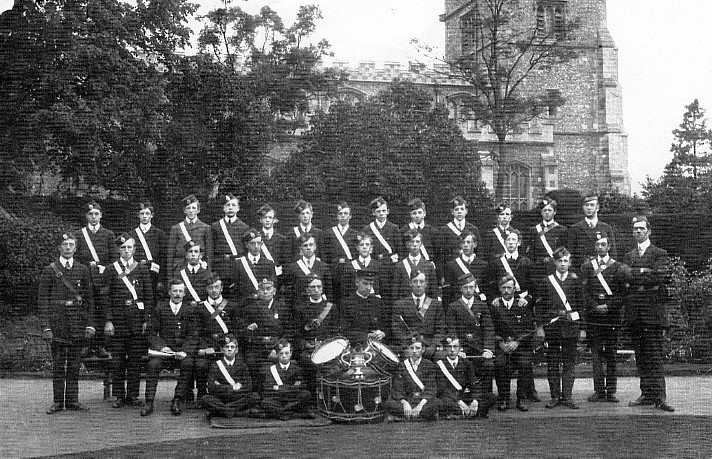
The Tring Lads’ Brigade
[Ed. - the names of some shown here now
appear on the
Tring War Memorial]
What her Ladyship seemed particularly struck with was the smart and
cleanly appearance of many of the lads who hailed from the the very
poorest quarters of the town, who now not only go to drill once a
week, but Sunday School and Church every Sunday. There is no
doubt that this organisation has met a great want, in getting hold
of boys [that] hitherto seemed unapproachable on the path of good.
The thing to be desired, however, is that there should be a large
room built in some central position for their use, and furnished
with games and papers, where the boys, would be free to go for an
hour or so every night in the week when they had nothing else to do,
where they could be warm and well looked after, and kept out of the
streets. The Church Lad‘s Brigade is to be congratulated,
however, for the kindly interest taken in it by Lady Rothschild and
other ladies of influence in the neighbourhood.
――――♦――――
TRING AND THE MOTOR CAR
by Jill Fowler, November 1998
The first mention of the car in Tring appears to be in November 1898
when the Bucks Herald stated briefly that “On Sunday a
Motor Car passing through the town came in for a considerable share
of attention.” Until then horses, and particularly those
pulling carts, all too frequently made the news by causing a variety
of accidents, some of them fatal. Horses for transport were
not phased out until well into the next century but the better off
Tring residents did become interested in the motor car, Gilbert
Grace of the High Street shop was said to be the first person to own
one.

The vehicle, seen
outside the Tring Silk Mill, belonged to Walter Thomas,
manager of
Tring’s electricity power station located in the old Silk Mill
By June 1901 accidents involving cars became news. On a Sunday
evening a car being driven from Wendover hit the bank in Aylesbury
Road, the occupants being thrown out and some injured. Tring’s
Dr Le Quesne dealt with their injuries and they were driven home to
Luton by a conveyance (probably horse drawn) from the Rose and
Crown. The following Wednesday four gentleman were in a car
coming through Tring and decided to blow the hooter. This
started a pony in a trap belonging to Mr F. Johnson, the jeweller
that was standing outside his shop. Mr Johnson rushed to the
pony's head but both were thrown over and the trap damaged.
The paper said “The gentleman in charge of the car, who gave his
name as Mr W. V. Thome of 43 Cedar Street, New York, amply
compensated Mr Johnson for the damage to his trap and for his own
personal injuries, before proceeding on his journey.”
During the next few years several Tring firms applied to sell motor
fuel, though many people have had their doubts about the car, as
more reports reached the paper of frightened horses and injured
people. In August 1905, Harry R. Pope of London was charged at
Berkhamsted Sessions with speeding through Tring at 34 mph.
Since the Police in those days were only supplied with bicycles one
wonders how Mr Pope was convicted. The method sounds too
simple to be true - “Evidence was given by P.S. Hewitt and P.C.
Alldridge of defendant passing the 27th milestone from London at
9.22 and by P.C. Davis to his passing the 31st milestone at 9.29.
Their watches, the constable added, were checked at 8.30 that
morning.”
The same year the Automobile Association was founded when the speed
limit was still 20mph. It was said they would warn their
members if they were approaching a speed trap. The following
year, 1906, hill climbing tests were held at Aston Hill with 40 to
50 cars starting from the Rose and Crown. Graces were
servicing cars in their workshops in Parsonage Place and Wright and
Wrights had been established for some years, though not under that
name until 1910.
By the 1920s the motor car was no longer a rarity and nowadays
people living in the older part of Tring know the disadvantages of
their homes built in roads not built to accommodate the motor car.
Just a hundred years after the residents came out to gaze at the
Motor Car, they are more likely to watch as a pony and trap passing
by, as they occasionally still do.
――――♦――――
TRING STATION - TRUTH AND HALF TRUTH
by Tim Amsden, April 1999.
Many a traveller has wondered why Tring station sits peacefully in
the countryside, a mile and a half from the town that bears its
name. Looking for a gnarled old country swain to explain it,
he will be told it was all because of old Lord Rothschild, who
didn’t want a railway through his park. It serves well enough,
but isn’t, unfortunately, even remotely true.
The railway, promoted in 1833, sought the quickest route from London
to Birmingham. It had to negotiate the barrier of the Chiltern
Hills and was unable, so it was believed, to operate on steep
gradients. Robert Stephenson, its builder, chose the Gaddesden
valley, but local landowners resisted and the valley of the
Bulbourne, further south, was selected. From a height of some
120 metres at Cow Roast, this route reached a peak of 130 metres at
Folly Bridge before falling to 100 metres at Great Seabrook near
Cheddington. Even so it requires a cutting of some 17m deep
between the station and Pitstone, at the highest point on the whole
line.
Lord Rothschild had the temerity not to be born until 1840.
His grandfather had, it is true, rented Tring Park as a summer
residence in 1834 from its owner, the industrialist William Kay.
The Rothschilds did not own Tring Park until 1872, thirty five years
after the railway was built. William Kay would probably have
relished a railway but there was little likelihood one would ever
come to Tring, unless it were a branch line like the one later
proposed to come over the hills from Chesham.
Tring sits beside the old Roman route through the Chilterns which
ran westwards from St Albans to Alcester. Had the promoters of
the London to Birmingham railway wanted to take in Aylesbury or even
Oxford on their line it is still unlikely that it would have come
any closer to Tring than it does. The plateau on which Tring
stands has the 160 metre contour at Pendley Beeches and at Tring
Hill a further 30 metres to tackle! A cutting twice the depth
of the one eventually built would have been out of the question, and
a tunnel of that length would have been grotesquely expensive.
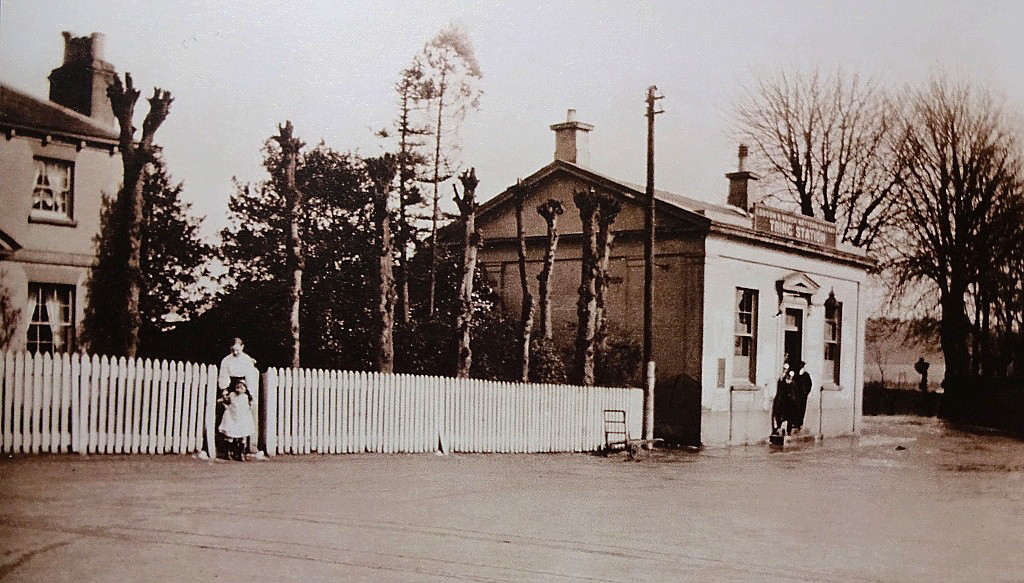
Above: Tring Station
ticket office once upon a time - the Station Master’s house is on
the left.
Below: Tring's first station motor bus,
1914.
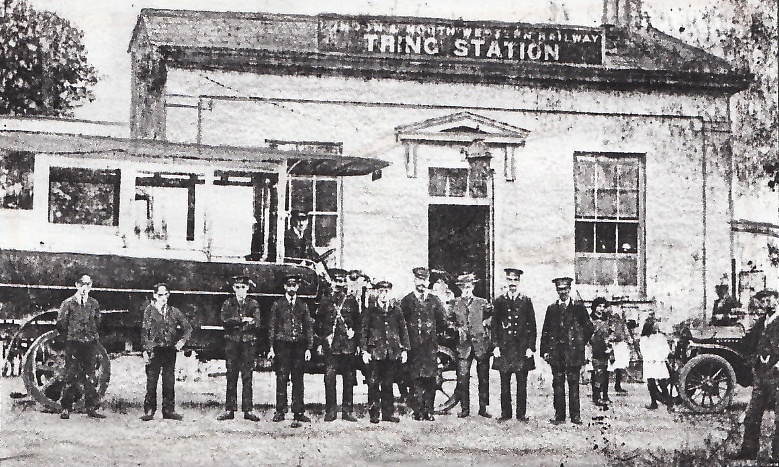
In any case, there was little to be gained by serving a place of
fewer than 3,000 souls. The line was designed to convey
freight from the industrial heartland of England to London and the
sea, not to provide a passenger service to a string of little
villages. It succeeded in eclipsing the Grand Junction Canal,
built only thirty eight years before on the same route and for all
the same reasons.
Originally there was to have been a station at Pitstone, but Tring
businessmen such as the Browns petitioned for one nearer Tring.
The railway later split the difference by building one at
Cheddington also, largely for the benefit of the Rothschild mansion
at Mentmore. Station Road was built in 1838 and when there was
a Lord Rothschild to whizz along it to the station and his job in
the City, whizz along it he did.
――――♦――――
MEMORIES OF TRING IN THE THIRTIES
by Jerry Spencer, May 2004.
I left school in 1930 at the age of 14, as most children did in
those days. My first job was at Brandons the large furniture
shop in the High Street. I worked in the shop and also had to
unpack parcels. Tea services would arrive in huge crates up to
five feet high, tightly packed in straw and I used to climb inside
and gradually unpack them. No article was ever broken.
The furniture, mats and carpets were sold upstairs and the crockery
downstairs in the basement, stacked on shelves. The customer
would go downstairs to choose a tea set, which in those days cost
about 3s-6d! There was also a workshop outside where the men
used to repair furniture. I liked to creep out there and watch
them at work. Every year the Rothschild family would go to
London for the season and the men from Brandons used to go to the
Mansion to do any repairs that were needed. They had a special
room for their use but you had to wear slippers if you went into any
room in the Mansion. I went too and one of my jobs was to
check all the windows in case they needed new sash cords. Also
the carpets were taken up one by one and taken to an area of gravel
behind Jones, the saddlers shop, run by Mr Jones and his daughter.
Then an old man, I think named Mr Gomm, used to beat the carpets
with a long stick, then sweep them before they were returned to the
Mansion.
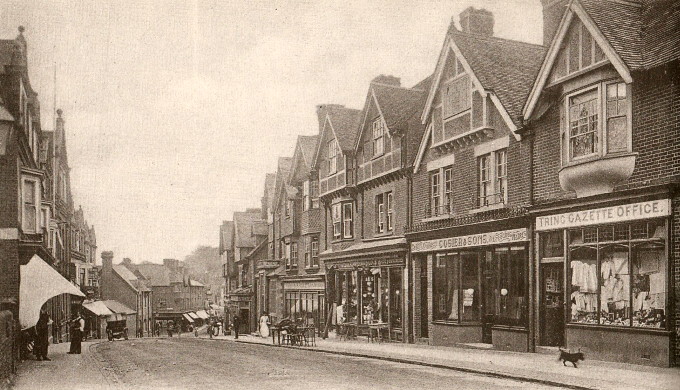
Brandons shop is
third from the right.
Brandons was one of Tring’s biggest shops and they had another
branch in Chesham. They continued to trade until quite late in
the century. Many Tring families still have furniture and
other household items bought from Brandons in their houses.
I earned 12s-6d a week and stayed there until I was 16. One
thing I did learn was to pack up parcels expertly, a skill that
still comes in useful from time to time. Then, two years after
I left school, an opportunity arose for my career to take a
different turn, a move that had a profound influence on the rest of
my working life. In 1932, when I was 16, my dad spoke to a man
in a pub and heard that Robins and Marriott, the garage in the High
Street, now Metcalfes, were looking for an apprentice. I had
worked for Brandons, the furniture store, for two years, but was
keen to go into the motor trade. I was taken on at 2s-6d a
week. In those days it was generous to pay an apprentice, many
families had to pay for their son’s training. I started by
selling petrol and helping to repair cars and motor bikes.
I had my first motor bike at 16. The local undertaker had had
a bad accident on his motor bike and my boss told me to call in on
the way home and ask if he would sell the badly damaged bike for £3.
This he did and it was taken to the garage and repaired, and 6d a
week was taken from my wages until it was paid for. As I lived
at New Mill in those days it was very useful. Petrol was then
1s-6d a gallon. I had a motorbike licence at 16 and a car
licence at 17. You didn’t take a test in those days.
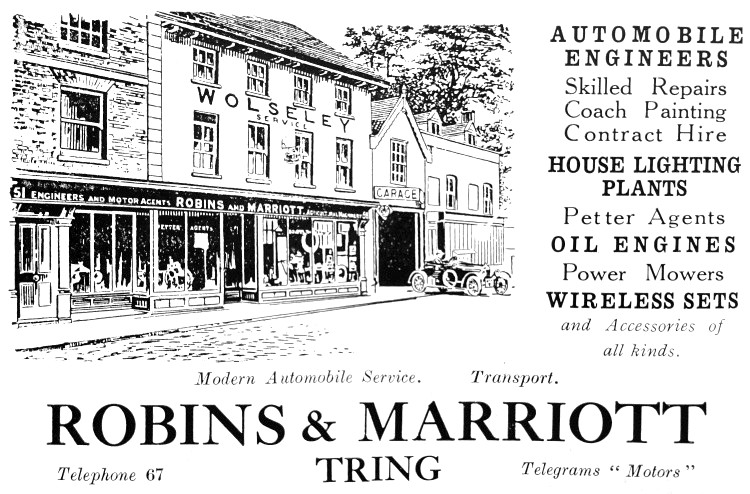
Lord Rothschild did not own a car himself so he hired one from
Robins and Marriott. It was a large Wolseley which was kept
for his use. The chauffeur, Albert Christopher, was employed
by Robins and Marriott and that was his only job. He had to
take Lord Rothschild to London and bring him back most week days.
Sometimes when they came back early he would ask the chauffeur to
pick him up in 30 minutes to take him to the Museum. As half
an hour wasn’t long enough for the chauffeur’s lunch break (he was
due an hour) I had to put on a blue jacket over my dirty overalls
and a peaked cap and go to pick up Lord Rothschild. The only
words he ever spoke to me were “Take me to the Museum”; and when he
got out of the car he would just say “Wait”. By the time Lord
Rothschild came out the chauffeur was back and I would ride his bike
back to the garage. When the Rothschilds had visitors they
would hire another car and I would pick them up or take them back to
the station. I had to go up to the Mansion every Saturday
morning and collect any empty petrol cans, fill them up and take
them back to the garages at the Mansion.
I enjoyed my apprenticeship and later joined forces with the foreman
of the garage, Ernie Goddard, and we opened our own garage in Akeman
Street. While I had the garage I taught several people to
drive, then charging 1/- an hour if using the pupils’ own cars.
This led to me becoming a driving instructor after selling the
garage and I started the Tring and District School of Motoring.
I started with a Morris 8, charging pupils 7s-6d, or 5s-0d in their
own car. I fitted dual controls to the car and for many years
was the only driving instructor in Tring. I still meet people
who remind me that I taught them to drive.
――――♦――――
‘BORN IN THE SAME YEAR AS THE QUEEN’
by Pam Cockerill
“I remember I remember the house where I was born”. Thus
begins a poem by Thomas Hood which I learnt as a child. I too
remember the house where I was born on 15th October 1926 — at least
it wasn’t a house, it was above a shop called Sanders & Sons which
belonged to my paternal grandparents Alfred & Alice Sanders.
The shop was situated in Tring High Street in what is now the
entrance to Dolphin Square, together with another shop, a jewellers
called Clements. My grandparents lived in the house which lies
back from the road between the HSBC Bank, or the Midland Bank as it
was then called, and Nash’s previous office, formerly the doctor’s
surgery. The house was called Hastovan and still is to this
day. The doctor who delivered me was
Dr O’Keefe and the doctor who lived above the surgery was
Dr Knox. These were the only two doctors to look after the
welfare of all Tring residents, plus Nurse Shaw, a very formidable
lady!
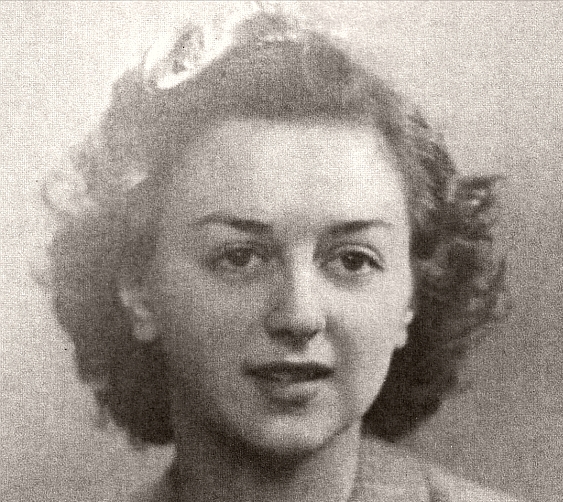
Pam in 1945.
At the time of my birth my grandparents had virtually retired and my
Dad Douglas and his brother Harold, the two youngest of my
grandparent’s five children were running the shop. I have very
vivid memories of that shop. It was a fruiterers, greengrocers
and confectioners, double fronted, with a huge supporting pillar
right in the middle where a barrel of grapes in crushed cork always
stood. As you entered the shop the fruit was all beautifully
arranged in an arc in front of you with vegetables to the left and
cakes (my favourite was Kunzel’s Spider Cake) sweets and chocolates
to the right. My Dad was a brilliant florist and he made the
most beautiful bouquets and wreaths which were kept in a very dark
and damp cellar until collected. No delivery vans then!
Even in his seventies he was still making holly wreaths at
Christmas. They were always made entirely of holly (no fir or
other greenery as is used today) and decorated with fir cones and
teasels which he just tipped with gold or silver paint — all natural
foliage, nothing artificial at all.
Now a word about my Mum. She was a Wilstone girl, hence my
fond attachment to that village. Her name was Winifred Edwards
and she lived with her parents and young brother Arthur who was
fifteen years her junior, in a thatched cottage with a large garden
and a “two holer” out the back. Sadly three other children
were born before Arthur but as so often happened in those days all
three died in infancy. Arthur was like a big brother to me and
I spent many happy holidays in Wilstone and it was in the canal
there that he taught me to swim. You have to remember that
this was at the time of the working boats and my mind now boggles at
the thought of what was in that canal — never mind the cows that
came down into the water to drink at a spot specially made for
them!! Even as young teenagers a group of us would go swimming
there in the summer and none of us suffered any ill effects. I
think we must have been immunised by the canal water.
As an infant I went to a little school run by two ladies. Miss
Huckvale was the headmistress and Miss Cummings her assistant.
The house still exists and stands next to the cemetery at the
entrance to Donkey Lane. The only pupil I can remember by name
is Peter Lief, son of the founder of Champneys. At seven years
old my parents sent me to Berkhamsted Girls School and I travelled
in the care of the two daughters of Mr. Smith the chemist. We
travelled by train as did the boys attending the Boys School and
there was a strict rule that forbade boys and girls sharing the same
carriage. At seven years old this was of no interest to me but
by the time we were teenagers we tended to ignore this rule.
Unfortunately my friend Jean Chase and I were split upon and we were
sent to the headmistress and promptly defrocked i.e. we lost
our prefect status. I don’t seem to remember it had the
desired effect! I had a wonderfully happy childhood, both at
school and at home. There were few restrictions on where we
could play — in the fields behind Manor Road — no housing estate
then — in the woods and it seems to me that every winter we went
tobogganing in Tring Park. It was carefree, safe and all
innocent fun, sadly today is so different.
I can remember Tring when it was full of shops no cafes, charity
shops or estate agents, except Browns. There were at least
five butchers; the London Central Meat Co., Wrights, Singlehursts,
and Sallerys in the High Street, and the Co-op in Albert Street.
There were numerous grocers, Glovers, the Co-op, and the
International in the High Street, plus Batchelors in Akeman Street,
and Howletts and Bakers either end of Queen Street. There was
a haberdashers run by ‘Toddy’ Ives and his Wife. They had
underwear hanging from racks and when you went into an apparently
empty shop a face would suddenly appear between the
‘unmentionables’, his or his wife’s. I remember she wore her
hair in ‘earphones’. They also kept a parrot — a very
unfriendly bird that would give you a nip if it got the chance.
I could name many more shops in the High Street plus all the little
ones in the side streets and those a bit further afield in Longfield
and Beaconsfield Roads all somehow making a living, serving their
communities and being a meeting place to exchange the gossip of the
day. There were two cinemas as well,
The Regal very new and modern and The Gaiety [Ed. - first named
The Empire], which we called the flea pit, probably quite
unjustly.
I have lived in several houses in Tring throughout my life.
The shop where I was born, my grandparent’s house before moving into
a house in Manor Road when I was about four, then my Dad and his
brother Harold bought a plot of land in Dundale Road and had two
identical bungalows built —this would have been in the mid 1930’s.
The two back gardens were joined up and a full size tennis court
laid out. We had some wonderful tennis parties throughout the
summer. Then came the war which devastated so many lives. To
be honest it did not have a great impact on my life. My Dad
was declared unfit for military service — he had developed rheumatoid
arthritis — so he joined the St Johns Ambulance Brigade. I was
still at school and when it ended I was working in the Midland Bank
in Berkhamsted.
At home we grew lots of vegetables, kept chickens — I distinctly
remember a white leghorn cockerel, a vicious bird that flew at you
every time you entered its pen. We had evacuees, and every Saturday
night there was a dance at the Church House - the highlight of the
week. This was regularly attended by the Halton RAF apprentices who
vied with the local lads for the girls’ attention. Although they
were only sixteen and seventeen they had the advantage of wearing a
uniform. I still have the brass wheel that my particular boyfriend
gave me from his jacket sleeve when he left.
After the war we moved to Surrey where my Dad bought a business and
where I met my future husband John. For various reasons the
move didn’t work out and after some time we came back to the place
that was home and settled in Longfield Road. My Dad also
bought a house called Adeyfield in the Western Road, because he
thought he would like to retire there and watch the world go by.
He never did.
John and I were married in May 1951 at St Peter and St Paul and
lived in Adeyfield for a time. Our daughter Alison was born
while we were living there. In 1958 we bought a plot of land
in Beaconsfield Road; Sid Horne was a local builder who had decided
to retire, and ours was the last house he built. Our son
Timothy arrived in 1961. When he was old enough to go to
school I decided it was time to find something to do other than
housework — never my first priority as my daughter will tell you —
and I went to Wilstone School as a classroom assistant. I
enjoyed working with children and when the school closed in 1971 I
was lucky that Wigginton School needed a secretary. I stayed
there for 20 years until I retired. Both schools were typical
village schools within a close community and I soon knew all the
parents as well as the children, and still do today.
Recently I had some work done in the garden and two chaps arrived,
one much younger than the other, in his twenties. He looked at
me and said “You don’t recognise me do you Mrs Cockerill”. I
said, very politely “No, I’m sorry but I don’t”. He said “I’m
.... ..” and without thinking I said “You were a right pain!” and
the older man promptly added “and he still bleeding is!” Happy
days.
I still live at 34 Beaconsfield Road, and still find plenty of
things to do to keep me busy. Sadly John died nine years ago
but I am lucky to have my daughter still living with me. Tim
is married and I have a lovely daughter-in-law Lyn and two equally
lovely grandchildren Molly and Hugh. I have been blessed with
many friends, some of very long standing, others of more recent
years, and many in the church community, especially at St Cross in
Wilstone where my parents were married and my two grandchildren
baptised. Life seems to have come full circle. I have
had a long life and a happy life in the midst of a loving family for
which I am truly grateful. A final thought. If anyone
doesn’t know what a ‘two holer’ is, just let me know. My
granddad grew wonderful vegetables but we won’t go into that!!
Editor: this article was originally
published in Comment magazine June 2016. Pam was born
in 1926 and died in October 2021.
――――♦――――

<>
|
|